Posts Tagged ‘Rural Fire Service’
Friday, January 6th, 2012
[This article was initially published by Tigerquoll on CanDoBetter.net 20090626, in the aftermath of the Victorian Bushfires which conflagrated on 20090207]
.
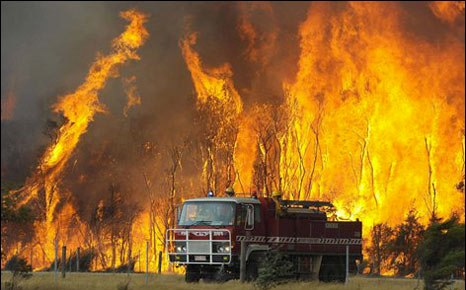
The Australian Press Council has just dismissed a complaint against Sydney Morning Herald columnist Miranda Devine about her ‘opinion’ article back on 12-Feb-09 ‘Green ideas must take blame for deaths.’
But although provocative, Devine’s ‘opinion‘ article pales in comparison to the social implications of headline media reporting of extreme bushfire risk immediately BEFORE the bushfires! [‘Complaint against Devine dismissed’, SMH, 26-Jun-09, p.5]
Note that the date of the article was made while fires still raged. Also, note that the article was published on the front page of the Herald, indicating that the editor was unusually highly supportive of it. Normally, the Herald’s ‘Opinion and Letter’s‘ articles are printed way back around page 12.
The main inflammatory bits drawing criticism in Devine’s article were:
.
“It wasn’t climate change which killed as many as 300 people in Victoria last weekend…it was the power of green ideology over government to oppose attempts to reduce fuel hazards before a megafire erupts.” [and] “If politicians are intent on whipping up a lynch mob to divert attention from their own culpability, it is not arsonists who should be hanging from lamp-posts but greenies.”
 . .
Clearly, the article’s emotive tone expresses anger, frustration, retaliation and spiteful provocation. Perhaps this is understandable given the scale of the disaster and public shock, disbelief and for many, the personal loss. People react in their own way to tragedy. Devine’s article upset many and presumably it was intended to in order to unseat entrenched community complacency about Australia’s bushfire management generally.
If so I agree with her motive, but not her method.
The Australian Press Council considered the article’s lead paragraphs as ‘dogmatic’ and ‘confrontational’. But the complainants asserted that the article breached a number of Press Council principles. Yet the Press Council’s principles or journalism are vague and advocate the rights of journalists rather than prescribing responsibilities. The principles include noble motherhood ideals such as being accurate, fair and balanced, not being misleading, acting in the public interest and not being biased against minority groups. So then perhaps the complainants were misguided and it is not surprising that the Press Council found that publicising the article didn’t breach any of these principles.
Devine was accused of incitement in her article, which is a fair interpretation.
On Crikey, Greg Barns questions whether Devine’s article incited violence. He suggests that in “these fraught times, where there is a smell of blood in the air as well as smoke, as communities, individuals and the media look to find someone to blame for the Victorian bushfires, are just the environment where incitement flourishes.” Barns goes on: “To date no one appears to have acted on the inflammatory statements of Ms Devine and her fellow sabre rattlers, but that does not matter, says the law. It is enough that the incitement to commit a offence occurs, it is irrelevant that no one acted on the statement made.”
[Source: ^http://www.crikey.com.au/2009/02/17/did-miranda-devine-incite-violence/]
.
In the press at the time, local anger in Gippsland was palpable and vigilante feeling clearly was at breaking point. But it was targeted at the arsonists.
No-one rationally can blame the conservation movement and its ecological principles for the Victorian Bushfires. The bush and its creatures were innocent victims of the fires, just like people, livestock and houses. Many tend to forget this in the wake of such enormous tragedy. But one must blame the arsonists.
Yet it wasn’t apparently just arsonists that caused the ignitions and it is the task of Brumby’s Royal Commission to investigate and find out the causes of all the ignitions. However, thereafter, the real problem solving should start, but I doubt Brumby will have the will and instead will want to close the political door on the bushfire tragedy – just like the bushfire investigations of the past and interstate.
.
But let’s turn more importantly to the media incitement before the bushfires!
The Age newspaper in Melbourne during the Victorian heatwave through January and early February 2009 immediately preceding the bushfires, ran headlines repeating the extreme bushfire risk. On 6 February 2009, the day before the fires started, indeed the Premier of Victoria John Brumby issued a warning about the extreme weather conditions expected on 7 February:
“It’s just as bad a day as you can imagine and on top of that the state is just tinder-dry.
People need to exercise real common sense tomorrow”.
.
Was this wise?
To serial dormant bush arsonists and to would be arsonists, this frenzied media excitement about such pending doom surely would have been been read by arsonists and I suggest directly incited the bush arson. Yet at the time there was no complaining or realisation of this.
If bush arsonists are found to have been the key causes of the ignitons and indeed of the most catestrophic firestorms that burt alive people for instance Marysville and Kinglake, then the investigation must focus on the root cause of the arsonist motivations. I argue that media arousal through its sensationalising of the bushfire risk and its portrayal of the bushfire threat is directly responsible and accountable for actual bush arson. Let’s see what the Royal Commission concludes.
.
Compare the Media Restrictions on Reporting of Suicide
.
Getting back to the subject of press responsibility, let’s look at where the Press Council actually prescribes reporting restrictions on journalists.
Take the subject of media reporting of suicide.
In the Council’s General Press Release No. 246 (i) (July 2001) on Reporting of Suicide, The Press Council:
“calls upon the press to continue to exercise care and responsibility in reporting matters of suicide consistent with government attempts to curb the suicide rate. Research shows that an association exists between media portrayal of suicide and actual suicide, and that in some cases the link is causal. So the Press Council recommends journalists avoid reporting which might encourage copy-cat suicides and which unnecessary references details of or the place of a suicide, or which uses language which trivialises, romanticises, or glorifies suicide.”
[Source: ^http://www.presscouncil.org.au/pcsite/activities/guides/gpr246_1.html]
.
So on the sensitive topic of suicide, the Press Council is quite prescriptive, moreso than in its broader principles for journalists rights.
Serious thought needs to be given by all levels of government and by the Press Council as the media industry’s representative body to the reporting of bushfire risks. Just as links can be drawn between the media portrayal of suicide and actual suicide, causal links can be drawn between the media portrayal of bushfire risk and bush arson arousal.
This is a matter for criminal psychology. Media sensationalising of bushfire risk and of bush arson is known to incite bush arson and copy-cat bush arson. This is a little known and neglected form of social deviant behaviour, yet it has become increasingly prevalent and deadly.
There is an urgent need for national level investment into bush arson criminology research and investigations. Media rights and responsibility for reporting bushfires play a critical role, perhaps more than many of us realise.
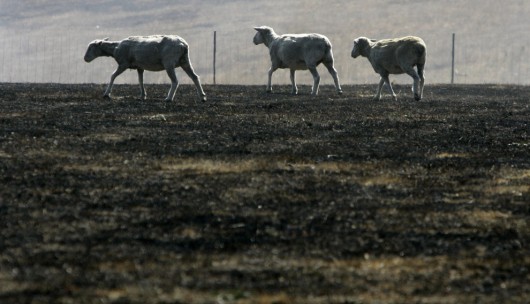 . .
Editor’s submission to ABC Four Corners ahead of its programme ‘Two Days in Hell’ aired 20090216
[Source: ‘Two Days in Hell’, by Reporter Quentin McDermott, ABC TV Four Corners programme, ^http://www.abc.net.au/4corners/content/2008/s2489831.htm]
Dear Quentin,
Thank you for highlighting this perennial problem.
The Australian Institute of Criminology reported last month that half of Australian bushfires are deliberately lit. Bushfire research needs to go further to evaluate whether in fact of the most damaging most are deliberately lit.
Test: If one excluded arson ignitions and their related spotover fires (between 29 Jan at Delburn to 8 Feb) would the firestorms have occurred? Assuming the answer is no, then clearly arson must be Australia’s key focus in combating the impacts of bushfire. Unlike the other two causes of bushfire, (lightning and accident) which are random, bush arson targets the worst conditions, upwind of a specific target and often involving multiple ignitions.
The term ‘fire bug’ is too docile and to start seriously dealing with it, we must change the perception and the language. Bush arson has become so deadly and catastrophic a crime that it warrants the term ‘pyroterrorism’. See the application of this term in the recent California fires. [^http://www.lilith-ezine.com/articles/thepyroterroristsarecoming.html]
The forthcoming Royal Commission into the Victorian Bushfires of 2009 risks concluding similar theme recommendations as the 2004 COAG Enquiry into the 2003 Canberra Firestorm, which itself repeated those of many previous bushfire enquiries. The implementation of any recommendations requires budget, timeframe and an independent federal watchdog accountable to the public. I will be analysing its terms of reference.
Aside from serious resourcing of bush fire fighting (nationalising it, building approvals, building codes, etc), the key systemic problem is the cultural disconnect between bushfire research and fire fighting practice. Criminal arson investigation needs to be a permanent and dedicated arm of bushfire management, properly resourced with primary data collected from all Australia and overseas using the best criminal psychologists and with a proactive mandate.
In NSW, the government set up Strike Force Tronto to investigate serial bush arsonist after the Christmas 2001 bushfires. Then the government got complacent, other priorities emerged and it was disbanded in 2005.
But following a series of arson bushfires in 2006 (with houses lost in (Picton and Cattai) the force was reinstated on 26 Sep 06 (Daily Telegraph p1). Reactive sporadic resourcing of bush arson investigation clearly isn’t effective.
To seriously address the main cause of deadly bushfires, a national organisation needs to be permanently established and perpetually funded to focus on criminal investigation into bush arson/pyroterrorism with a mandate to recommend deterrent policies and practices across Australian bushfire fighting as well as the media.
Media reporting leading up to the 7-Feb-09 firestorms, simply incited dormant serial arsonists. Go back and read The Age and television media in the days before and after 29 Jan when the first bush arsonist struck at Delburn (south wast of Churchill). The front page of The Age on Saturday 7-Feb-09 read: ’44 degree heat “as bad a day as you can imagine”
– which was a quote from of all people the Victorian Premier made to the general public the day prior.
Just like the media policy of not reporting suicides due it being known to encourage copy cats, so too media reporting of heatwaves and of extreme bushfire conditions needs to be tempered to avoid inciting dormant serial arsonists.
.
‘The Fire Starters’ – ABC TV Four Corners programme of 2003 about bush arson in NSW, following a spate of bush arson
[Source: “The Fire Starters”, ABC TV Four Corners programme, 20030224, ^http://www.abc.net.au/4corners/content/2003/20030224_fire_starters/default.htm]
.
‘It’s a summer ritual: fire fighters across Australia battling hundreds of bushfires, putting themselves at risk to save other people’s lives and property. But these men and women are confronting dangers they should never have to face. While most fires, like the recent Canberra inferno, are ignited by lightning strikes or by stray sparks, investigators say a growing proportion of fires are being deliberately lit – by serial arsonists playing havoc in the bush.
As Australia tallies the cost of one of its worst bushfire seasons, Four Corners looks at the devastation that firebugs wreak on the landscape and the fear they generate in vulnerable communities. Reporter Stephen McDonell focuses on two communities where a firebug has been at work. In one case the arsonist has been caught and jailed; in the other the offender remains at large, apparently still living among anxious neighbours who suspect his every move.
McDonell builds a profile of offenders who typically crave power and status. For all their fundamental inadequacies, arsonists often presents normally enough to other people – even to their fellow volunteers in the local fire service. Authorities are fighting a difficult battle against these elusive, superficially unremarkable people, whose crimes rely on secrecy, solitude and destruction of evidence.’
.
Interview by ABC journalis Stephen McDonell with NSW Police Assistant Commissioner John Laycock (edited transcript):
.
STEPHEN MCDONELL: It’s been suggested by some people there should be a full time arson squad in NSW, do you think that we’re getting to the stage where that’s what we need?
ASSISTANT COMMISSIONER JOHN LAYCOCK: Well there is at the moment. With the establishment of Strike Force Tronto last year, that will be ongoing on a needs basis and we saw very quickly in October this year how quickly that Task Force got up and running.
STEPHEN MCDONELL: You don’t think though there’s a need for developing some expertise in the area, have a team specifically designed just to look at arson?
JOHN LAYCOCK: Well, we have that now with Strike Force Tronto and in addition to the permanent team, we’re also training up investigators right across the state to look at the fire investigations across the board so we’re fairly well on top of that now.
STEPHEN MCDONELL: Can you just tell us the thinking that’s led to you having a team that is assembled as the need arises rather than having a full time squad?
JOHN LAYCOCK: Look Strike Force Tronto is virtually full time on a needs basis. We started off in 2001 with the large volume of fires in the state. It took a little time to get that up and running but that expertise and the database and the skill they’ve learnt from that has now flowed to, very quickly, starting up (Strike Force) Tronto II. So, whilst ever the actual need is there, the strike force will be there to assist. In addition to that, you’d normally find that between bushfires or wild fires there’s a three or four year gap. We have 94, 97, then 2001, on this occasion we’ve had two years in a row so the need this year is unusual to say the least.
STEPHEN MCDONELL: If you were asked if bushfire arson is getting worse, what would you say to that?
JOHN LAYCOCK: No I don’t think so. I think the reporting of it has improved. All our local area commands now are on the scene as soon as it occurs, they’re investigating the fires straight away. In the past that might not have always been the case. With Strike Force Tronto up and running, all fires are investigated and eliminated: whether it’s accidental or lightning or what have you and others are put aside for further investigation.
STEPHEN MCDONELL: So you don’t think we’re getting more bushfire arson?
JOHN LAYCOCK: I think the community’s become more up to date and aware of arsonists being involved. The majority of our people apprehended are done by information from the public and, in a lot of cases, actually apprehended by people from the community and people are just sick and tired of people being involved lighting fires so they’re doing something about it which is great.
STEPHEN MCDONELL: So, in other words, are you saying that while the statistics might bear out something of an increase, it’s really just that more people are being caught?
JOHN LAYCOCK: That’s one interpretation. In addition to that: our scientific skills, our forensic skills – with both the Rural Fire Service and the NSW Fire Brigade, with our own forensic people – have enhanced tremendously. Technology has increased. There’s a lot more out there that we can use, we can tap into, and plus the skill level of our people on all fronts has also increased.
STEPHEN MCDONELL: Just on the question of your ability to investigate bushfires, what would you say is the area that has come on the most, that is changing the fastest and is enabling you to catch people?
JOHN LAYCOCK: Look without doubt the technology, our forensics, the scientific people, our research people. We tap into overseas data; we tap into overseas experts. Our own local people here are well down the road to being able to fully investigate a fire, to track it from A to Z, with help from the community. Our crime scene investigation has enhanced tremendously and it’s improving all the time. There’s satellite inventory; there’s aerial photography; there’s video links; there’s a whole raft of things we can tap into now.
STEPHEN MCDONELL: I’ve seen some statistics that show that while the offending appears to be going up, the clear up rate remains static, what would you attribute that to?
JOHN LAYCOCK: Probably wouldn’t agree with that entirely and I think I can play with figures with the best of them. For example, in our 2001 fires, there were 22 people charged straight out with arson. There was another 130, 140 odd processed for various breaches, minor breaches of the Rural Fires Act and other Acts of parliament. None of those persons have re-offended again this year to our knowledge. Now most arsonists I think you’d have to agree are not sort of rocket scientists and one would expect that, if they were continuing to offend, they would be apprehended. That hasn’t occurred. So I don’t think the clear up rate has decreased per se. I think the instance of reporting and investigation activity has increased.
STEPHEN MCDONELL: What do you think that those statistics tell us about the impact that catching people has on their likelihood of them re-offending when it comes to bushfire arson?
JOHN LAYCOCK: Look, again, with the number of people we’ve processed – from those that went to gaol, to those who were fined, cautioned or were conferenced – none of those people have re-offended to our knowledge, which indicates whatever process did take place, whether it be gaol or a caution or bond or what have you, has worked in that case. In addition to that, all persons processed have been, their details have been given to our our local area command so at the first sign of an investigation being required, those people would have their names up as a possible suspect to get looked at so the heat is on if I can use that phrase for those people locally in the first instance.
STEPHEN MCDONELL: We’ve spoken to one person who suggested that part of the problem with catching people when it comes to bushfire arson is that crime scene can be totally destroyed, especially if the fire moves over it a couple of times, would you agree with that?
JOHN LAYCOCK: Probably to the contrary and our forensic capacity with the Rural Fire Service, the Fire Brigade, our own forensic people now has increased to the extent that we can get a lot of information from the crime scene long after the fire has gone.
STEPHEN MCDONELL: So, even if a big fire has moved through an area, there’s still a lot there at the crime scene?
JOHN LAYCOCK: There’s a lot of signs, there’s a lot of expertise, and we tap into a lot of stuff still left behind and, as I keep saying, cold fires leave hot trails.
STEPHEN MCDONELL: How sophisticated would you describe the bushfire arsonists as compared to other criminals?
JOHN LAYCOCK: Not very sophisticated: they’re certainly not rocket scientists. Arson is an unusual crime because there’s no financial profit or gain. There’s normally no great planning goes into it: it’s unusual, to say the least. I think that the people involved are possibly not of brilliant intelligence.
STEPHEN MCDONELL: Do you think that, across Australia, we’re doing enough to catch bushfire arsonists?
JOHN LAYCOCK: Look we can always do more but here in NSW the community is up and running. The number of reports we get through crime stoppers, continually, for the police to act upon is encouraging to say the least. The number of a people apprehended at fire scenes, lighting fires where people got out of their cars and physically grabbed hold of them where they’re capable of doing it and just hand them over to the police just shows a no nonsense approach. The three organisations working together -with the Rural Fire Service and the Fire Brigade – it’s ongoing, I think we’re doing a lot, we can always do more but, as each year goes on, our expertise increases.
STEPHEN MCDONELL: Do you ever worry about discussion in the media relating to bushfire arson: that it might encourage copycat behaviour?
JOHN LAYCOCK: And certainly I think that does occur (but) to what extent…? but we have to weigh up the public interest – the need for the public to know what is happening around them. We’ve found, with the community support, with the open campaigns we’ve been running, they’ve been nothing short of outstanding.
STEPHEN MCDONELL: If we could just look at why one of the cases that your team has dealt with, the Burgess case, can you just tell us, from the outset, what the idea was in terms of when you heard that he was hanging around this brigade in the Blue Mountains, what did you intend to do, especially in relation to that brigade?
JOHN LAYCOCK: We first got some information not long after the fire season started in relation to that offender and I can only speak in general terms. Information is fine but we needed sufficient evidence to place him before a court, it was obvious to us that he was a very firm suspect. We then tapped into the support from the Rural Fire Service. We spoke to the executive and we virtually placed him under surveillance. They did report issues to us. We had our surveillance teams actually follow him from site to site. In the meantime, in the background, our forensic people were linking the crime scenes together and, of course, you’re aware he’s virtually working from one part of the state to the other – from the Central Coast down to Albury and then up to the Blue Mountains, so a fairly wide area – but we were able to link him into all those scenes. Our surveillance people tracked him into places where fire had been lit, just a painstaking good thorough investigation by Strike Force Tronto Police.
STEPHEN MCDONELL: Now, for people who don’t know much about crime and the detection of crime, can you explain what this linking of the crime scenes was and how significant that was?
JOHN LAYCOCK: It was quite significant because each offender has their own way of doing things or committing a crime – quite, sort of, peculiar to anybody else – so no arsonists would work alike, as a general statement. So the way in which the fires are lit at all locations were almost identical and that gives us a guide only to the fact that he was the person responsible. But it’s not just the crime scene, it’s sightings, information from other people in the community, people from the Rural Fire Service that felt things weren’t quite right, that was all fed into our system to give us enough to get out and charge him.
STEPHEN MCDONELL: So, is this right, it was something like that there was a pattern to his behaviour, is that right, that he was doing similar sorts of things?
JOHN LAYCOCK: There was a pattern to the way he was committing the offences, which showed very promising signs to us.
STEPHEN MCDONELL: What could you say about Burgess’s behaviour that led you to actually apprehend him?
JOHN LAYCOCK: It wasn’t so much his behaviour, I think it was the investigation results from behind the scenes. Evidence from witnesses, admissible evidence we could place before a court, the linkages between the forensics at the crime scenes and the fact that we were able to place him at those particular sites either before, after or during a particular fire breakout. That’s the cold hard evidence that we need.
STEPHEN MCDONELL: I think you were saying something before about his behaviour being consistent and that, because he didn’t vary it so much, you were able to say right, bang, bang that he did all those, lit all those fires. Can you just tell us a bit about that?
JOHN LAYCOCK: Yeah, look we have to prove each individual fire by itself. We just can’t say that we think it’s him because all the fires appear to have lit the same way. We need admissible evidence to place before a court to put him at the scene and, what happens at the crime scene, there’s only a small part of the jigsaw. So each investigation needs to be complete and be able to stand in its own right but the common factor was the linkage between the crime scenes.
STEPHEN MCDONELL: Can you tell us a bit about how Cameron Burgess’s behaviour assisted police in catching him?
JOHN LAYCOCK: I think: in the way that he exposed himself to other members of the fire fighting fraternity; that he was always there at the crime scene, he was in the locations at the time when the fires went up; on occasions he actually went to help fight the fire, it didn’t do him any favours when we started putting the brief together.
STEPHEN MCDONELL: So you could see the same sorts of things coming up again and again?
JOHN LAYCOCK: There was a pattern there but there was also admissible evidence that we could use and place before a court.
STEPHEN MCDONELL: What was found out about Cameron Burgess’s mental state?
JOHN LAYCOCK: According to the psychologist’s report that was tended to the court at the time, he had no mental illness or condition, probably can’t comment too much further than that.
STEPHEN MCDONELL: Was there anything significant about this Burgess case?
JOHN LAYCOCK: Look all police investigations are virtually quite different but the one thing that struck out with him was that he was operating in such vast distances away from each other: the Central Coast, Albury, Wagga and the Blue Mountains, entrenching himself in with the local fire fighting sort of type community and committing offences of that nature. It was quite unusual. Most arsonists tend to work fairly close in one area.
STEPHEN MCDONELL: Why do you think he was moving from area to area?
JOHN LAYCOCK: I don’t really know, I never could find that out. I think he had contacts in all those locations and he entrenched himself in with the local community.
STEPHEN MCDONELL: Have you ever had a problem with other members of the volunteer brigades being arsonists?
JOHN LAYCOCK: Look occasionally with all large organisations you might have one or two, even a handful of people who fall through the cracks and obviously Burgess is one of those but probably no more than any other group from the community. We’ve found offenders from all walks of life so I don’t see that as particularly unusual or significant.
STEPHEN MCDONELL: How important do you think it is for the bushfire brigades to be vigilant in keeping an eye out for arsonists in their midst?
JOHN LAYCOCK: Very important. We work so closely together, we find that most captains of all the outfits, all brigades, do report anything unusual to us through their own chain of command. Obviously, if they’ve got one of their own out lighting fires, it’s a big risk. It does them damage so they are very supportive of the police and, on quite a few occasions, they have been entrusted and vice versa with sensitive details and they don’t breach security so the probability of that sort of continuing can’t be excluded but it’s small on the scale.
STEPHEN MCDONELL: Do you think that the checks are sufficient at the moment: the background checks of people wanting to join volunteer brigades?
JOHN LAYCOCK: Look that’s a question I think for the Rural Fire Commissioner, Mr Koperberg. Whether that would solve all the problems I don’t know. I don’t profess to be an expert. It’s a question of how far you go and what expense and what are the risks involved if you don’t…? There’s the odd one that falls through the crack but whether what you’re going to do is enough to weed them out I don’t know.
STEPHEN MCDONELL: If you could look into your crystal ball – 5, 10 years down the track – paint us a bit of a picture of the likelihood that you’ll be catching more bushfire arsonists.
JOHN LAYCOCK: I think, from what we’ve developed now, is that if you’re going to go out and start lighting fires, the probability of being caught is fairly high. Our forensics, our working with the other agencies, our scientific, our expertise, our skill base, our investigators, the probability of being caught is very high. As the years progress that capacity’s only going to increase and will get better and better. The end result will be that, if you’re going to be an arsonist, you better pack a toothbrush because you’ll be going to gaol.
.
October 2011: Arsonist hits Blue Mountains again
.
Katoomba blaze the “perfect storm”
[Source: ‘Katoomba blaze the “perfect storm’ by reporters Krystyna Pollard and Michael Cleggett, Blue Mountains Gazette, 20111026, ^http://www.bluemountainsgazette.com.au/news/local/news/general/katoomba-blaze-the-perfect-storm/2336384.aspx]

[Ed: Monday 24th October 2011 was the first hot day for some months in the Blue Mountains and it was a day where winds were forecast to pick up in the afternoon from the west. The bush arsonist must have known this. What were the media reports ahead of this? What language did the media use on Sunday 23rd October to describe the weather forecast?]
.
‘Arson may be behind the Mountains’ second major bushfire outbreak in a month that saw hundreds of schoolchildren and residents evacuated, and damaged seven homes.
The blaze broke out shortly before 2pm on Monday, October 24 at Cliff Drive near Echo Point and forced the evacuation of 450 children from Katoomba High School and 25 residents from 12 nearby homes.
Tourists were also warned to stay away from the area and fears were held at the height of the blaze for landmarks including Katoomba’s Scenic Skyway, Lilianfels and Echoes Hotel, with the Skyway’s terminal scorched by the flames.
“During the blaze, seven homes sustained minor damage, and a garden shed was destroyed,” a police statement said.
Local detectives and Strike Force Tronto officers together with Rural Fire Service investigators are looking into the cause of the fire, with initial inquiries suggesting the fire “may have been deliberately lit”, according to a police statement.
Blue Mountains Crime Manager Inspector Mick Bostock told reporters yesterday (Tuesday) while the fire had “two points of origin”, investigators believed it was lit by the one arsonist. He could not say exactly how. Police were interviewing one witness, an overseas tourist living in Bondi, who reported a fire in the area, he said.
Firefighters worked on Monday night to secure the fire edges and by Tuesday morning it had burned out 20 hectares of bushland and was no longer a threat to property. Fire and Rescue NSW sector commander for the incident, Inspector Kernin Lambert, said he was amazed no homes had been lost, with conditions creating “the perfect storm”.
“On this occasion the timely response and some brilliant firefighting from Fire and Rescue NSW and the Rural Fire Service saved the day,” he told the Gazette. “We are told that fire has not burned through that area for 35 years and the high accumulation of bush . . . the angle of the slope, wind direction, the aspect, it was like the perfect storm in terms of potential for fire disaster.
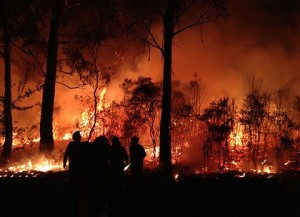
.
‘Blue Mountains bushfire: police investigate arson’
[‘Blue Mountains bushfire: police investigate arson’, Sydney Morning Herald, 20111025, ^http://www.smh.com.au/environment/weather/blue-mountains-bushfire-police-investigate-arson-20111025-1mgvj.html]
.
‘A bushfire in NSW’s Blue Mountains, which was believed to be deliberately lit, is now under control after firefighters back-burned overnight. Police are investigating if arson is to blame for a bushfire that is burning in the Blue Mountains for a second day. The blaze, which started about 2pm yesterday, has scorched 19 hectares at Katoomba, west of Sydney, and forced the evacuation of a high school.Detectives from the Blue Mountains Local Area Command and Strike Force Tronto and the Rural Fire Service will investigate the circumstances of the fire burning between Cliff Drive and Katoomba Street.’
.
‘Arson investigators probe Katoomba blaze’
[Source: ‘Arson investigators probe Katoomba blaze’, ABC, 20111025, ^http://www.abc.net.au/news/2011-10-25/arson-investigators-probe-katoomba-blaze/3598740]
.
Detectives specialising in arson cases are heading to the Blue Mountains to investigate a bushfire that damaged seven homes at Katoomba yesterday. Police believe the blaze was deliberately lit near Cliff Drive or Katoomba Street about 2:00pm (AEDT). Officers would like to speak with anyone who saw any suspicious behaviour in the vicinity.
.
Tags: ABC TV Four Corners, Australian Press Council, bush arson, bushfire arsonist, bushfire management, Delburn Fire 2009, hazard reduction, Katoomba bushfire, media responsibility, Rural Fire Service, serial bush arson, stir dormant bushfire arsonists, Strike Force Tronto, Victorian Bushfires 2009
Posted in Blue Mountains (AU), Threats from Bushfire | No Comments »
Add this post to Del.icio.us - Digg
Tuesday, December 20th, 2011
 The Blue Gum Forest’s fire-scarred trees of December 2006
some of which have graced the Grose Valley in the Blue Mountains for hundreds of years.
Photo: Nick Moir (Source: Sydney Morning Herald, 20111211, Front Page) The Blue Gum Forest’s fire-scarred trees of December 2006
some of which have graced the Grose Valley in the Blue Mountains for hundreds of years.
Photo: Nick Moir (Source: Sydney Morning Herald, 20111211, Front Page)
.
The following articles are drawn from those by Gregg Borschmann, the first of which hit the front page of the Sydney Morning Herald on Monday 11th December 2006, following the massive bushfire conflagration that coalesced in the Grose Valley on 23rd November 2006.
From the community’s perspective, no noticeable lessons have been since learned by the Rural Fire Service (RFS) responsible. The prevailing bushfire management culture is that unless private property is directly, bushland is not valued and so not defended from bushfire. Indeed the approach is to let a bushfire burn as a defacto hazard reduction, so long as it doesn’t threaten human life or property. The RFS does not consider bushland an asset worth protecting from bushfire no matter what its conservation value, so with such a mindset such an ecological tragedy could well happen again.
.
‘The ghosts of an enchanted forest demand answers’
.
[Source: ^http://www.smh.com.au/news/national/the-ghosts-of-an-enchanted-forest-demand-answers/2006/12/10/1165685553891.html]
.
‘More than seventy years ago this forest inspired the birth of the modern Australian conservation movement. Today Blue Gum Forest stands forlorn in a bed of ash. But was it unnecessarily sacrificed because of aggressive control burning by firefighters focused on protecting people and property? That is the tough question being asked by scientists, fire experts and heritage managers as a result of the blaze in the Grose Valley of the upper Blue Mountains last month.
As the fate of the forest hangs in the balance, the State Government is facing demands for an independent review of the blaze amid claims it was made worse by control burning and inappropriate resources.
This comes against a backdrop of renewed warnings that Australia may be on the brink of a wave of species loss caused by climate change and more frequent and hotter fires. There are also claims that alternative “ecological” approaches to remote-area firefighting are underfunded and not taken seriously.
In an investigation of the Blue Mountains fires the Herald has spoken to experienced fire managers, fire experts and six senior sources in four agencies and uncovered numerous concerns and complaints.
- It was claimed that critical opportunities were lost in the first days to contain or extinguish the two original, separate fires.
- Evidence emerged that escaped backburns and spot fires meant the fires linked up and were made more dangerous to property and heritage assets – including the Blue Gum Forest. One manager said the townships of Hazelbrook, Woodford and Linden were a “bee’s dick” away from being burnt. Another described it as “our scariest moment”. Recognising the risk of the backburn strategy, one fire officer – before the lighting of a large backburn along the Bells Line of Road – publicly described that operation as “a big call”. It later escaped twice, advancing the fire down the Grose Valley.
- Concerns were voiced about the role of the NSW Rural Fire Service Commissioner, Phil Koperberg.
- Members of the upper Blue Mountains Rural Fire Service brigades were unhappy about the backburning strategy.
- There were doubts about the mix and sustainability of resources – several senior managers felt there were “too many trucks” and not enough skilled remote-area firefighters.
- Scientists, heritage managers and the public were angry that the region’s national and international heritage values were being compromised or ignored.
- There was anecdotal evidence that rare and even common species were being affected by the increased frequency and intensity of fires in the region.
- Annoyance was voiced over the environmental damage for hastily, poorly constructed fire trails and containment lines, and there were concerns about the bill for reconstruction of infrastructure, including walking tracks.
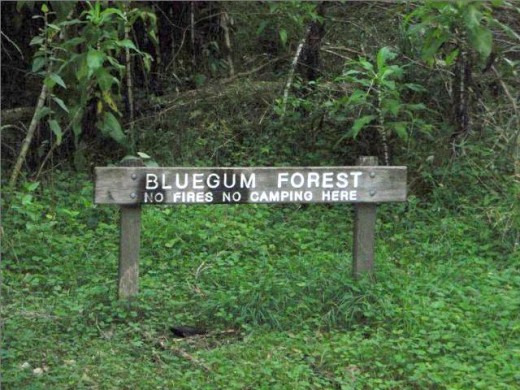
The fire manager and ecologist Nic Gellie, who was the fire management officer in the Blue Mountains for the NSW National Parks and Wildlife Service during the 1980s and ’90s, says the two original fires could have been put out with more rapid direct attack.
“Instead, backburning linked up the two fires and hugely enlarged the fire area … what we saw would be more accurately described as headfire burning, creating hot new fire fronts. While it protected the town of Blackheath, the plateau tops burnt intensely – and that created new problems both for management of the fire and the protection of biodiversity.
“When extreme fire weather, hot days and high winds arrived as predicted, the expanded fire zone was still not fully contained – and that was the cause of most of the high drama and danger that followed.”
In that dramatic week, Mr Gellie confronted Mr Koperberg with his concerns that the commissioner was interfering with the management of the fire by pushing hard for large backburns along the northern side of towns in the Blue Mountains from Mount Victoria to Faulconbridge, along what is known in firefighting circles as the “black line”.
The Herald has since confirmed from numerous senior sources that “overt and covert pressure” from head office was applied to the local incident management team responsible for fighting the fire.
There were also tensions relating to Mr Koperberg’s enthusiasm for continuation of the backburning strategy along the black line – even when milder weather, lower fuel levels and close-in containment were holding the fire.
Several sources say the most frightening threat to life and property came as the fire leapt onto the Lawson Ridge on “blow-up Wednesday” (November 22) – and that those spot fires almost certainly came from the collapse of the convection column associated with the intensification of the fire by the extensive backburns.
The Herald has also confirmed that
- The original fire lit by a lightning strike near Burra Korain Head inside the national park on Monday, November 13, could not be found on the first day. The following day, a remote area fire team had partly contained the fire – but was removed to fight the second fire. The original fire was left to burn unattended for the next couple of days;
- An escaped backburn was responsible for the most direct threat to houses during the two-week emergency, at Connaught Road in Blackheath. However, at a public meeting in Blackheath on Saturday night, the Rural Fire Service assistant commissioner Shane Fitzsimmons played down residents’ concerns about their lucky escape. “I don’t want to know about it. It’s incidental in the scheme of things.”
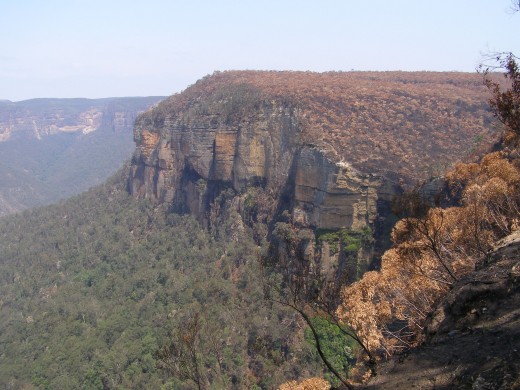 Blackheath escarpment broadscale backburn – “incidental in the scheme of things“?
(Photo by Editor 20061209, free in public domain, click photo to enlarge) Blackheath escarpment broadscale backburn – “incidental in the scheme of things“?
(Photo by Editor 20061209, free in public domain, click photo to enlarge)
.
Mr Koperberg, who is retiring to stand as a Labor candidate in next year’s state elections, rejected the criticisms of how the fire was fought.
He told the Herald: “The whole of the Grose Valley would have been burnt if we had not intervened in the way we did and property would have been threatened or lost. We are looking at a successful rather than an unsuccessful outcome.
“It’s controversial, but this is world’s best backburning practice – often it’s the only tool available to save some of the country.”
The commissioner rejected any criticism that he had exerted too much influence. “As commissioner, the buck stops with me. I don’t influence outcomes unless there is a strategy that is so ill-considered that I have to intervene.”
Mr Koperberg said it was “indisputable and irrefutable” that the Blue Mountains fire – similar to fires burning now in Victoria – was “unlike any that has been seen since European settlement”, because drought and the weather produced erratic and unpredictable fire behaviour.
.
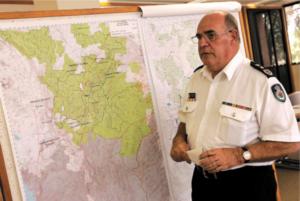 Phil Koperberg
NSW Rural Fire Service Commissioner at the time of the Grose Fire Phil Koperberg
NSW Rural Fire Service Commissioner at the time of the Grose Fire
.
The district manager of the Blue Mountains for the Rural Fire Service, Superintendent Mal Cronstedt, was the incident controller for the fire.
Asked if he would do anything differently, Mr Cronstedt answered: “Probably.” But other strategies might have also had unknown or unpredictable consequences, he said.
Jack Tolhurst, the deputy fire control officer (operations) for the Blue Mountains, said: “I am adamant that this fire was managed very well. We didn’t lose any lives or property and only half the Grose Valley was burnt.”
Mr Tolhurst, who has 50 years’ experience in the Blue Mountains, said: “This fire is the most contrary fire we have ever dealt with up here.”
John Merson, the executive director of the Blue Mountains World Heritage Institute, said fire management was being complicated by conditions possibly associated with climate change.
“With increased fire frequency and intensity, we are looking at a fundamental change in Australian ecosystems,” he said. “We will lose species. But we don’t know what will prosper and what will replace those disappearing species. It’s not a happy state. It’s a very tough call for firefighters trying to do what they think is the right thing when the game is no longer the same.
“What we are seeing is a reflex response that may no longer be appropriate and doesn’t take account of all the values we are trying to protect.”
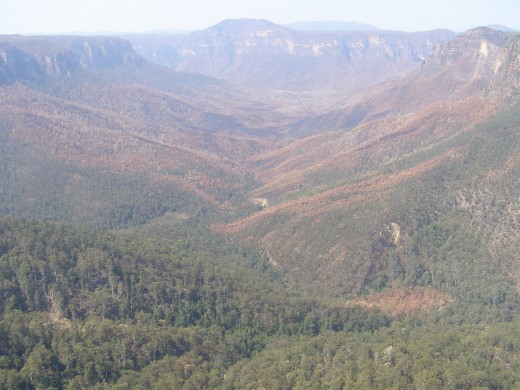 Grose Valley incinerated 23rd November 2006
(Photo by Editor 20061209, free in public domain, click photo to enlarge) Grose Valley incinerated 23rd November 2006
(Photo by Editor 20061209, free in public domain, click photo to enlarge)
..
‘The burning question’
.
[Source: ^http://www.smh.com.au/news/national/the-burning-question/2006/12/10/1165685553945.html]
.
‘A bushfire scars a precious forest – and sparks debate on how we fight fire in the era of climate change.
.
“Snow and sleet are falling on two bushfires burning in the Blue Mountains west of Sydney.” ~ ABC Radio, November 15 (2006).
The news report was almost flippant, something that could happen only in Dorothea Mackellar’s land of drought and flooding rains. Later that evening, two weeks from summer, Sydney had its coldest night in more than a century.
Over the past month – as an early summer collided with a late winter and a decade-long drought – NSW and Victoria have battled more than 100 bushfires. But of them all, last month’s Blue Mountains blaze reveals tensions and systemic problems that point to a looming crisis as bushfire fighters struggle to protect people, property, biodiversity and heritage values in a world beset by climate change.
The tensions have always been there – different cultures, different ways of imagining and managing the landscape. Perhaps they are illustrated by a joke told by two Rural Fire Service crew in the Blue Mountains. “How does the RFS put out a fire in your kitchen? By backburning your sitting room and library.” The joke barely disguises the clash between the imperative of saving lives and homes, and the desire to look after the land, and the biodiversity that underpins our social and economic lives.
For fire managers, whose first priority will always be saving people and property, the equation has become even more tortured with a series of class actions over fires in NSW and the ACT. As one observer put it: “These guys are in a position where they’re not going to take any chances. No one will ever sue over environmental damage.”
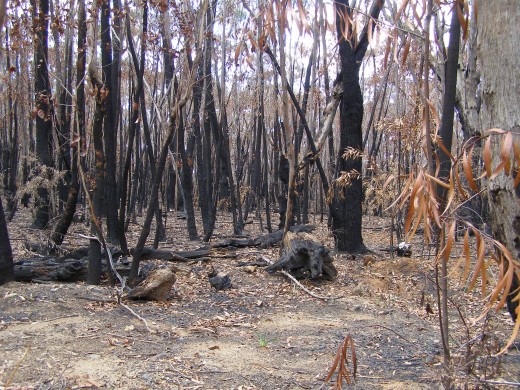
For bushfire management the debate tentatively started a couple of decades ago. The challenge was to do what poets, writers and painters have long grappled with – coming to terms with a country whose distinctiveness and recent evolutionary history have been forged in fire. Drought and climate change now promise to catapult that debate to centre stage.
It is perhaps no accident that such a defining fire has occurred in one of the great amphitheatres of the Australian story, the Grose Valley in the upper Blue Mountains. Charles Darwin passed by on horseback in 1836, and described the valley as “stupendous … magnificent”.
The Grose has long been a microcosm of how Australians see their country. In 1859 some of the first photos in Australia were taken in the valley. Proposals for rail lines and dams were forgotten or shelved. The first great forest conservation battle was fought and won there in 1931-32.
But now the valley is under threat from an old friend and foe – fire.
Ian Brown has worked on dozens of fires in the Blue Mountains. He is a former operations manager for the National Parks and Wildlife Service.
“All fires are complex and difficult, and this sure was a nasty fire … But we need lots of tools in the shed. Those hairy, big backburns on exposed ridges so close to a blow-up day with bad weather surprised me. Frightened me even.”
For Brown, even more worrying is the trend.
“Parts of the Grose have now burnt three times in 13 years and four times in 24 years. Most of those fires started from arson or accident. Many of the species and plant communities can’t survive that sort of hammering.”
Ross Bradstock, a fire ecologist, agrees. Professor Bradstock is the director of the new Centre for the Environmental Risk Management of Bushfires at the University of Wollongong, which is funded by the Department of Environment and Conservation and the Rural Fire Service. He says Australia stands out as one of the countries whose vegetation may be most affected by climate change.
Bradstock says that in south-eastern Australia the potential for shifts in fire frequency and intensity are “very high … If we’re going to have more drought we will have more big fires.”
But the story is complicated and compounded by the interaction between drought and fire. The plants most resistant to fire, most able to bounce back after burning, will be most affected by climate change. And the plants that are going to be advantaged by aridity will be knocked over by increased fire frequency. “In general, the flora is going to get whacked from both ends – it’s going to be hit by increased fire and climate change. It’s not looking good.”
.
Wyn Jones, an ecologist who worked for the wildlife service, says the extremely rare drumstick plant, Isopogon fletcheri, is a good example. There are thought to be no more than 200 specimens, restricted to the upper Grose. Last week, on a walk down into the Blue Gum Forest, Jones found three – all killed by the fire.
.
The NSW Rural Fire Service Commissioner, Phil Koperberg, has been a keen supporter of Bradstock’s centre. Asked if he agreed with the argument that the Grose had seen too much fire, Mr Koperberg replied: “It’s not a comment I disagree with, but had we not intervened in the way we did, the entire Grose Valley would have been burnt again, not half of it.”
The great irony of the fire is that it was better weather, low fuels and close-in containment firefighting that eventually stopped the fire – not big backburns.
Remote area firefighting techniques have been pioneered and perfected over recent decades by the wildlife service. In 2003 a federal select committee on bushfires supported the approach. It recommended fire authorities and public land managers implement principles of fire prevention and “rapid and effective initial attack”.
Nic Gellie, a fire ecologist and former fire manager, has helped the wildlife service pioneer ecological fire management. The models are there – but he says they have not been used often enough or properly.
Doubts have been expressed about the sustainability of the current remote area firefighting model. It is underfunded, and relies on a mix of paid parks service staff and fire service volunteers. Most agree the model is a good one, but not viable during a longer bushfire relying on volunteers.
The Sydney Catchment Authority pays $1 million for Catchment Remote Area Firefighting Teams in the Warragamba water supply area. It has always seemed like a lot of money. But it looks like a bargain stacked against the estimated cost of $10 million for the direct costs and rehabilitation of the Grose fire.
Curiously, one unexpected outcome of the great Grose fire may be that the valley sees more regular, planned fire – something the former wildlife service manager Ian Brown is considering.
“If climate change means that the Grose is going to get blasted every 12 years or less, then we need more than just the backburning strategy. We need to get better at initial attack and maybe also look at more planned burns before these crises. But actually getting those burns done – and done right – that’s the real challenge.”
It may be the only hope for Isopogon fletcheri.
 Fletcher’s Drumstricks (Isopogon fletcheri)
http://www.anbg.gov.au Fletcher’s Drumstricks (Isopogon fletcheri)
http://www.anbg.gov.au
.
. Distribution of Isopogon fletcheri is restricted to a very small area in the Blackheath district of the Blue Mountains.
Given restricted distribution, it is susceptible to local extinction due to environmental and demographic uncertainty and in particular pathogens such as Phytophthora cinnamomi. Distribution of Isopogon fletcheri is restricted to a very small area in the Blackheath district of the Blue Mountains.
Given restricted distribution, it is susceptible to local extinction due to environmental and demographic uncertainty and in particular pathogens such as Phytophthora cinnamomi.
What needs to be done to recover this species? Continued habitat protection.
http://www.threatenedspecies.environment.nsw.gov.au/tsprofile/profile.aspx?id=10440
.
.
What price now?
.
[Source: ^ http://www.smh.com.au/news/national/what-price-now/2006/12/10/1165685553948.html?page=2]
.
The Blue Gum Forest stands tall, straight and surreal in a fire-ground of still smouldering ash. Three weeks ago it was intensely burnt during bushfires in the Grose Valley. The future of the iconic forest – some trees are thought to be 200 to 300 years old – now hangs in the balance.
Last week the massive white-trunked blue gums were dropping their scorched leaves to reveal a stark and unrecognisable forest of tall trunks, bare limbs and fallen logs.
The director of the Colong Foundation for Wilderness, Keith Muir, did not speak out during the fires, but now he wants answers.
.
-
“Could the Blue Gum have been saved using other firefighting strategies that also protected life and property?
-
Was the fire that burnt this very special forest made more intense, unpredictable and extensive by massive backburning operations?
-
Was the Blue Gum sacrificed for the sake of a de facto fuel reduction exercise that didn’t consider heritage values?
-
We need answers. We need an independent inquiry. This is too important to happen again.”
.
In the early 1930s the Herald supported a campaign by bushwalkers to save the Blue Gum from grazing and agricultural development. It was the first successful Australian conservation campaign to protect an almost pure stand of tall mountain blue gum ( Eucalyptus deanei) on about 40 hectares of river flats in the rugged Grose Valley of the upper Blue Mountains. The bushwalkers raised £130 to buy the lease covering the forest and create the Blue Gum Forest Reserve.
The Herald visited the Blue Gum Forest again last week with a forest ecologist, Wyn Jones, and Ian Brown, former National Parks and Wildlife Service operations manager with overall responsibility for fire management. In 1994 Jones, then an ecologist with the service, helped to describe scientifically the rare and newly discovered Wollemi pine. He first saw the Blue Gum Forest more than 40 years ago. He has been involved with it professionally and as a bushwalker ever since.
He said the forest would re-shoot and regrow, but it remains to be seen when and how. He predicted its immediate future would be decided over the next six months. That would depend largely on the vagaries of climate. Severe wind storms, a hot dry summer or even persistent rain, fungal growth and insect attack could all compromise the forest’s ability to bounce back quickly.
More uncertain and potentially bleak is the long-term prognosis. Jones said changing fire regimes caused by humans could be further complicated by climate change, a recipe for more frequent and hotter fires.
The Blue Gum Forest has been burnt four or five times in less than 50 years: by wildfire in 1957, possibly 1968, and in 1982, 1994 and 2006.
“Without human interference , this forest may have been burnt once or perhaps twice in 50 years, not five times,” Jones said.
Jones is convinced cracks in majestic gums were caused by the fire. If they are deep enough to effectively ringbark the surviving trees, then the demise of the forest promises to be a slow and painful affair.
“The old Blue Gum Forest is gone,” he said. “We don’t know what the Blue Gum of the future will look like. We could be heading for strange and very different days.”
===========
‘Friends of the giants’
.
In 1931 the Herald’s conservation reporter, J.G. Lockley, writing under the name Redgum, led a campaign to save the Blue Gum Forest.
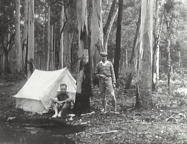
“To destroy the trees would be unforgivable vandalism .. if they are permitted to stay, they will stand straight and true for many generations … Every acre on which those grey gums are growing should be reserved for the distant days, when the nation will know the true worth of the giant trees, which are not understood.”
.
‘Blue Gum Lessons’
.
(Editor’s letter in the Blue Mountains Gazette, 20061220)
.
‘One of our most precious natural heritage assets, the Blue Gum Forest, has been allowed to be scorched by bushfire. This demands an independent enquiry into current fire fighting practices to ensure such a tragedy is not repeated.
Not a witch hunt, but what is needed is a constructive revision into improving bushfire fighting methods incorporating current research into the issue. The intensity and frequency of bushfires have become more prevalent due to disturbances by man, including climate change.
An enquiry should consider the assets worth saving; not just lives, homes and property but natural assets of the World Heritage Area. Fire fighting methods should seek to protect all these values. It seems back-burning, however well-intentioned, burnt out the Blue Gum. This is unacceptable. What went wrong? The future survival of our forests depends on how we manage fire.’
.
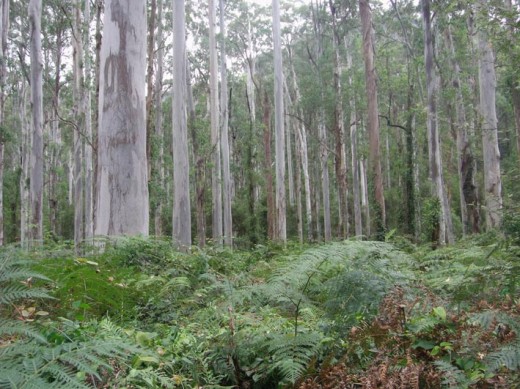
A Grose Valley Fire Forum was held at Mount Tomah on Saturday 17th February 2007, but the public were denied entry.
An independent enquiry was never conducted. A public enquiry was never conducted.
.
Tags: backburns, Blackheath, Blue Gum Forest, Blue Mountains, Blue Mountains World Heritage Area, broadscale backburning, ecological values, forest values, Grose Valley, Grose Valley Fires 2006, Isopogon fletcheri, Mal Cronstedt, old growth, Phil Koperberg, RFS, Rural Fire Service
Posted in Blue Mountains (AU), Threats from Bushfire | No Comments »
Add this post to Del.icio.us - Digg
Saturday, May 28th, 2011
Valuable fringe bushland of the Central Blue Mountains (BM) is steadily disappearing as a consequence of Blue Mountains (city) Council-approved housing development integrated with the associated hazard reduction burning that it invites.
Blue Mountains Council has become culturally conditioned to automatically squirm and acquiesce when any threat of a State Environmental Court appeal process that may be instigated to dare challenge Blue Mountains Council, despite a fair and rigorous environmental assessment and ruling. Local political pressure is such that now Blue Mountains Council staff are encouraged to give up and bend over, as if so urbane as to be beholden to developer intimidation. Yet for years such has become Blue Mountains Council’s urbane squeamish mindset, as if the staff and management came from overdeveloped Western Sydney (which most of them they have).
There are morally corrupt politics controlling land use development in the Blue Mountains ~ many are receiving a cut of perceived cheap, yet increasingly scarce, bushland habitat.
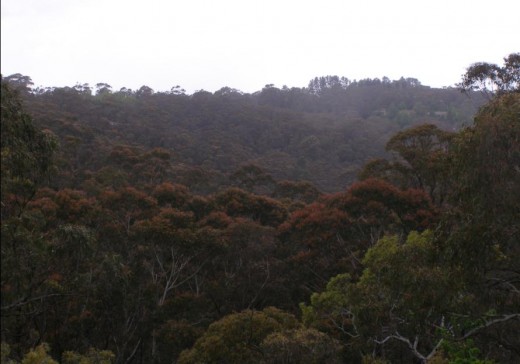 Thick natural bushland habitat just west of Katoomba
Central Blue Mountains Region.
New South Wales, eastern Australia. Thick natural bushland habitat just west of Katoomba
Central Blue Mountains Region.
New South Wales, eastern Australia.
.
.
Case in point:
.
Not so long ago, Blue Mountains Council approved this cypress pine cottage be built in/abutting thick timbered bushland on a west facing slope downwind of the prevaling westerly winds.
Bushfire risk mapping rated the site as ‘extreme’ bushfire risk, yet the cypress pine cottage got built. The builder/developer has long since profited and so moved on, leaving behind a bushfire vulnerable cottage on a site that should never have been built on in the first place.
But try telling a pro-development council that a property owner can’t develop his/her land!
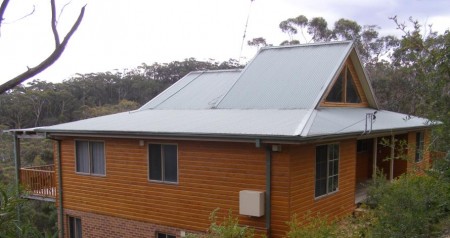 The cypress pine cottage, 2008
. The cypress pine cottage, 2008
.
The site was purchased in/abutting dense wooded bushland, which was slashed and bulldozed. Down from the house, around a dozen mature native trees were chainsawed to provide for escarpment views to the west.
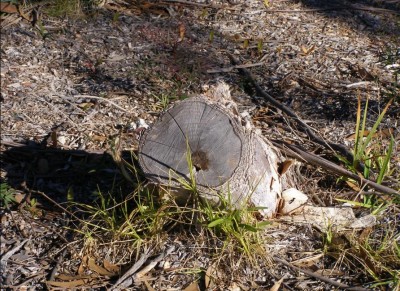 One of the chainsawed native trees
. One of the chainsawed native trees
.
The property has since been sold. Yet, the issue of a cypress clad cottage being approved in extreme fire risk bushland was raised with Blue Mountains Council’s senior development officer, Lee Morgan, on 25-Feb-2009 (Council ref. Customer Service Request #106889). But there was no response.
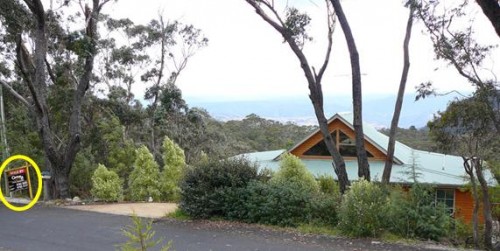 The cottage was sold in 2008…with views
…less the dozen chainsawed Eucalypts to make way for the views. The cottage was sold in 2008…with views
…less the dozen chainsawed Eucalypts to make way for the views.
.
It is typical of Blue Mountains Council’s planning approvals that they encourage development encroachment on the fringe bushland which separates the Blue Mountains National Park from the townships of the Central Blue Mountains.
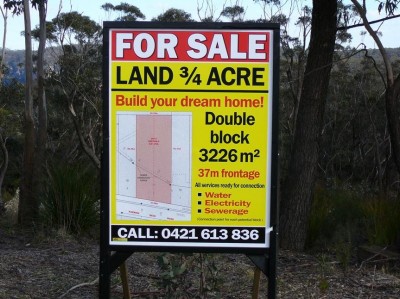
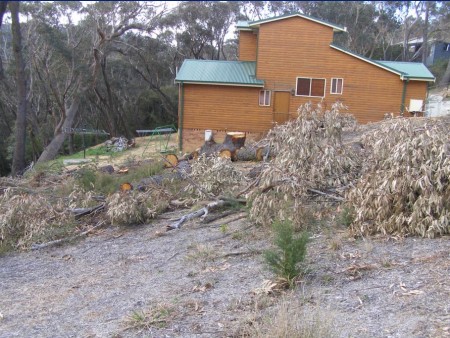 A nearby cottage of remarkably similar cypress pine cladding
has surrounding trees chainsawed and the vegetation slashed to bare earth. A nearby cottage of remarkably similar cypress pine cladding
has surrounding trees chainsawed and the vegetation slashed to bare earth.
.
.
Then comes the ‘hazard’ reduction
.
Housing development encroachment is being wedged deeper into fringe bushland, closer to the Blue Mountains National Park, many seeking the profit that escarpment views bring. The sites are indefensible against bushfire. Many are zoned extreme bushfire risk, yet these bush houses received Council building approval.
The Rural Fire Service (RFS) calls for hazard reduction because, with just its truck resources, it would not have access to defend these houses in the event of a serious bushfire. Co-incidentally, the property owners (developers) now cry for RFS hazard reduction to protect their ‘assets’ from the risk of bushfire. Co-incidentally, many property owners (developers) in the vicinity who have these new bush houses do the same.
Of course, to the fire-lighting cult, this is music to their ears and so the Rural Fire Service in cohorts with Blue Mountains Council rustled up a hazard reduction certificate. In September 2008, Blue Mountains Council’s Bushfire Technical Officer, Peter Belshaw, issued a Hazard Reduction Certificate for over 11 hectares of bushland and escarpment heath across Bonnie Doon Reserve to be burnt under a ‘hazard’ reduction programme. Click on image below for details.
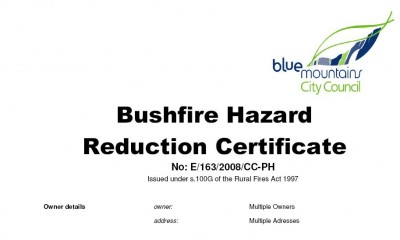 Click image to open PDF document Click image to open PDF document
.
Earlier that year in mid February (2008), some seven months prior, slashing of heathland and a watercourse had been carried out by a Rural Fire Service contractor in preparation for the hazard reduction burning ~ the fire-lighters just couldn’t wait.
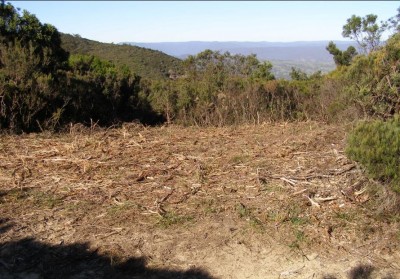 Blue Mountains escarpment is slashed by the RFS, a kilometre west of the cottage site. Blue Mountains escarpment is slashed by the RFS, a kilometre west of the cottage site.
.
.
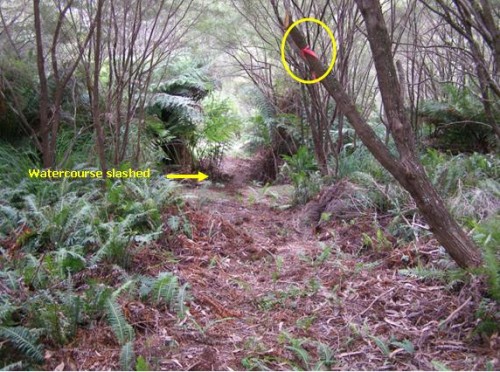 The RFS contractor slashed a trail for over 700m through heathland and through a riparian zone,
even before the Hazard Reduction Certificate was issued.
.
The RFS contractor slashed a trail for over 700m through heathland and through a riparian zone,
even before the Hazard Reduction Certificate was issued.
.
Then comes the intense HR burning:
.
Three years hence, mid afternoon on Friday 11th February 2011, smoke can be smelt and seen rising to the west on the horizon near Bonnie Doon Reserve. A call to emergency ‘000’ confirms that it is not a bushfire, but that official hazard reduction operations are underway. It is still well within the bushfire risk season.
.
Bonnie Doon Reserve is a natural wild area of about 22 hectares that includes a mix of bushland, heathland and upland swamp situated on the Blue Mountains escarpment at the western fringe of the township of Katoomba. It lies above Bonnie Doon Falls. The area is zoned ‘community land’ and ‘environmental protection’ and comes under the control and custodianship of the Blue Mountains Council. Bonnie Doon Reserve has a history of volunteer bushcare to conserve the still wild Blue Mountains escarpment habitat. The reserve is immediately upstream of the endangered Dwarf Mountain Pine (Microstrobos fitzgeraldii) and Leionema lachnaeoides (yellow flowering shrub) found almost nowhere else on the planet. The habitat conservation of both species, particularly the exclusion of fire are considered critical to their survival as a species.
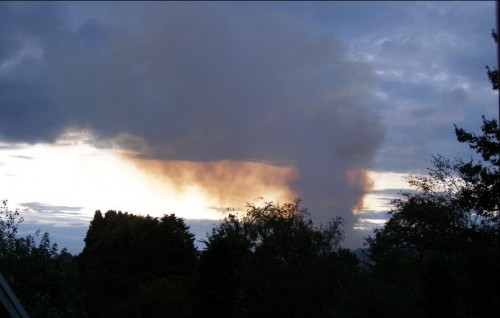 The ‘hazard’ reduction (HR) burning commences The ‘hazard’ reduction (HR) burning commences
.
From a distance of about two kilometres, I can see the smoke billowing strongly and its lasts for over two hours. The direction of the smoke places it around Bonnie Doon Reserve. The strength and density of the smoke indicates that it is more than light burning of ground cover. It is an intense but localised fire.
.
The aftermath of the burning:
.
We have our suspicions, but with other commitments we can’t get around there for some time to investigate the location affected to determine the scale and severity of the burning. In fact it isn’t until nearly three months later on Sunday 1st May 2011, that we inspect the burnt site. The fire was localised.
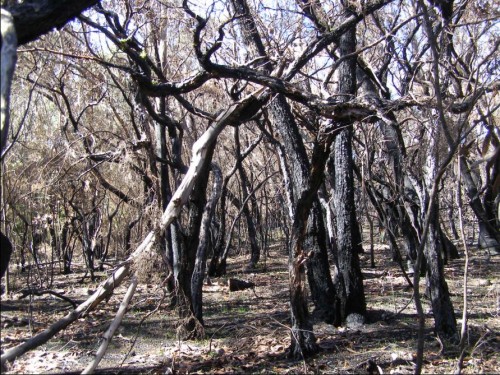 The aftermath
Three months on, evidence of more than just ground-cover has been burnt.
Deliberate intense burning has been allowed to penetrate deep into mature Eucalypts The aftermath
Three months on, evidence of more than just ground-cover has been burnt.
Deliberate intense burning has been allowed to penetrate deep into mature Eucalypts
.
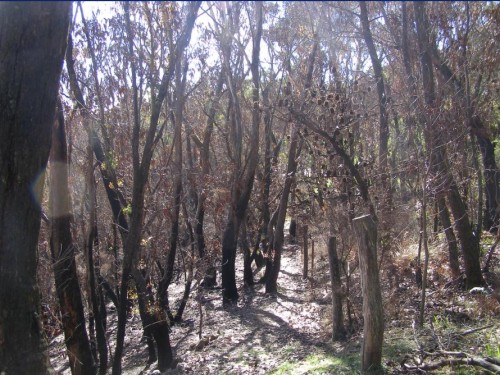
.
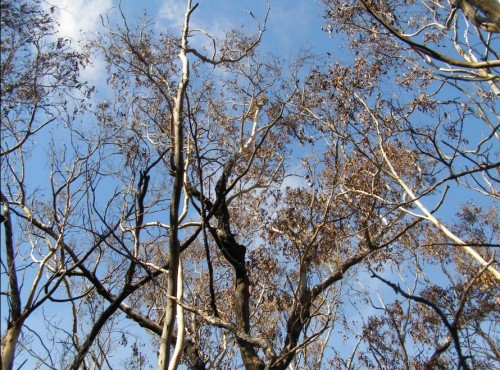 The fire was so intense that the flames reached into the tree canopy.
It must have been a blaze and half for RFS fire-lighters. The fire was so intense that the flames reached into the tree canopy.
It must have been a blaze and half for RFS fire-lighters.
.
.
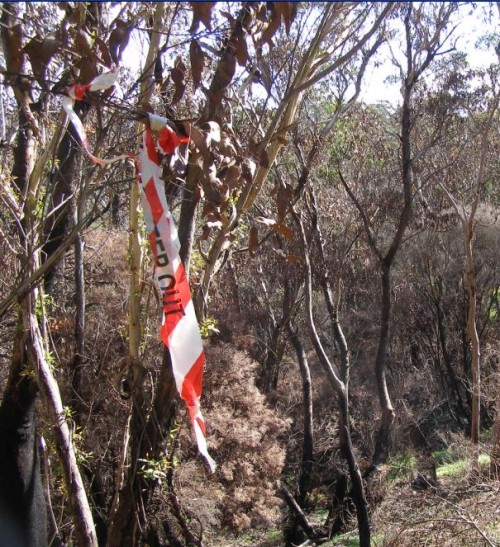 RFS telltale
. RFS telltale
.
The fire was indeed localised. It is very clear, still three months on, that this ‘hazard’ reduction burn had specifically targeted the native bushland surrounding the cypress cottage – an area of perhaps two hectares.
Consequence:
So not only has the developer of the cottage site completely destroyed the bushland on the site, but he has succeeded in having an additional two hectares burnt in the process all associated with the one cottage. Council’s initial approval of the cottage construction has directly led to the destruction of two hectares of what began as intact native bushland. The developer has profited from the bush, but in the process the ecological cost has been ignored ~ it is a perpetuation of a 19th and 20th Century single bottom line exploitation of the natural environment. It is happening across the Blue Mountains and being encouraged by Blue Mountains Council rules, practices and attitudes.
.
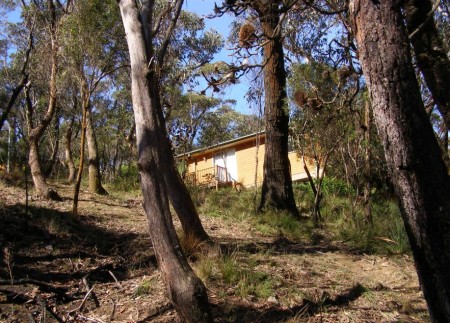 The cottage relative to the HR burn (aftermath) The cottage relative to the HR burn (aftermath)
.
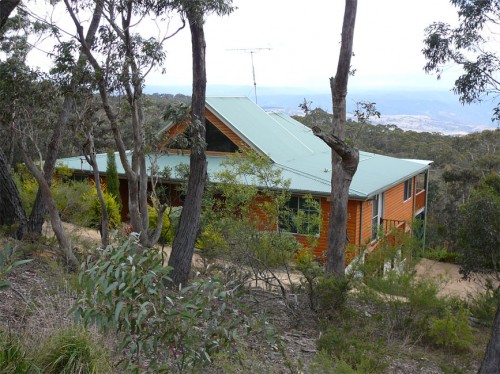
The cottage now with great views, plus an extra 2 hectares of cleared bush done cheap
Blue Mountains (city) Council making bushland-fringe development cheap
.
The ‘hazard’ reduction certificate process has become an insidious part of the development process across the Blue Mountains. The catalyst that is Council’s lax bushland protection zoning, is facilitating fringe deforestation. The combination of Council’s housing approvals on bush blocks with its ‘hazard’ reduction approvals have become a self-perpetuating twin mechanism for incremental encroachment into Blue Mountains fringe bushland, and it shows no sign of stopping.
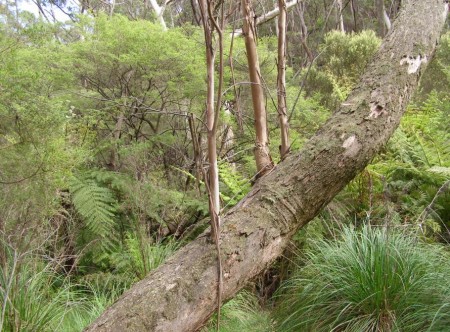 Bushland habitat at Bonnie Doon at risk of further burning Bushland habitat at Bonnie Doon at risk of further burning
.
Hazard reduction has become a cosy win-win-win-win outcome for all collaborators: (1) the builder/developer who profits, (2) the real-estate agent who get the sales commission (first when the bush block is sold, then again when the house is sold with views), (3) Council which earns developer charges in the short term and an expanded rate revenue base over the long-term, and (4) the RFS fire lighters who have become more adept and occupied lighting bushfires than putting them out.
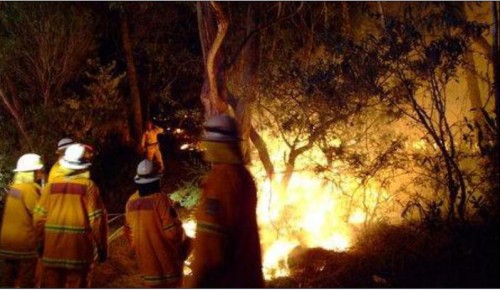 Fire-lighters look on during the Hazard Reduction Burn, Bonnie Doon Reserve Fire-lighters look on during the Hazard Reduction Burn, Bonnie Doon Reserve
.
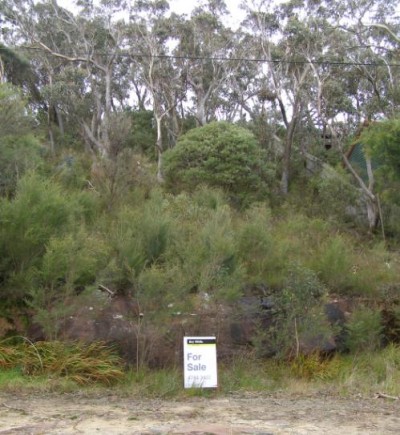 More bushland for sale
~ a ‘lose-lose’ outcome for native habitat and the remnant disappearing wildlife is supports.
More bushland for sale
~ a ‘lose-lose’ outcome for native habitat and the remnant disappearing wildlife is supports.
.
An harbinger of more burning for Bonnie Doon:
.
Of the eleven odd hectares of the 22 ha Bonnie Doon Reserve targeted by the RFS for slashing and burning on the hazard reduction certificate, nine hectares of bushland and escarpment heathland still stands to be burnt, which could happen anytime.
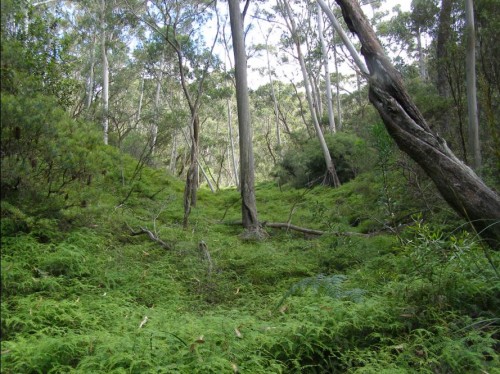 Bonnie Doon Reserve
on the western fringe of Katoomba township Bonnie Doon Reserve
on the western fringe of Katoomba township
(click photo to enlarge)
(Photo by us, so free in public domain)
.
– end of article –
.
 Blue Mountains escarpment is slashed a kilometre west of the house site Blue Mountains escarpment is slashed a kilometre west of the house site
, in preparation for over 11 hectares of buring Bonnie Doon Reserve
Tags: Blue Mountains City Council, Blue Mountains National Park, Blue Mountains World Heritage Area, Bonnie Doon Reserve, bush block for sale, bush fringe development, bush profits, bushland housing, Dwarf Mountain Pine, extreme bushfire risk, hazard reduction, hazard reduction certificate, housing encroachment, Leionema lachnaeoides, Microstrobos fitzgeraldii, property development, real estate land sales, Rural Fire Service, slashing
Posted in Blue Mountains (AU), Threats from Bushfire, Threats from Deforestation, Threats from Development | No Comments »
Add this post to Del.icio.us - Digg
Saturday, March 19th, 2011
Rural Fire Management Reform Series
Recommended Reform Initiative #03:
.
Formation of a ‘Civil Emergency Corps’
.
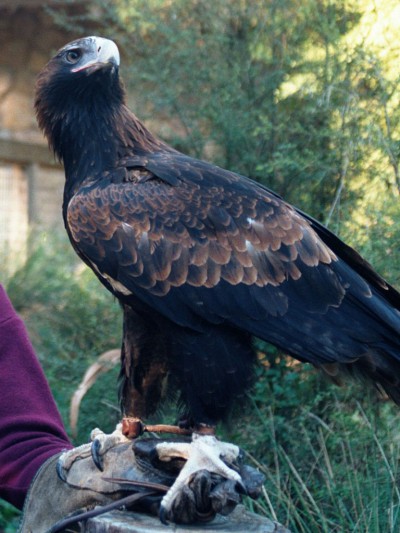 Australia’s Wedged-tailed Eagle (Aquila audax)
– an ideal mascot for a Civil Emergency Corps Australia’s Wedged-tailed Eagle (Aquila audax)
– an ideal mascot for a Civil Emergency Corps
© Photo reproduced with permission from Trevor Hampel,
Source: Trevor’s Birding website: ^http://www.trevorsbirding.com/
.
.
.
1. Purpose of this Reform Initiative
.
As one solution to Australia’s failing governance to mitigate and tackle national disasters (bushfires, storms, floods, drought, earthquakes,etc) I propose the complete overhaul of Australia’s current state-based disparate system. This reform initiative proposes to transform and consolidate the many state-based bushfire and emergency services across Australia and Emergency Management Australia into one standardised national professional body. I propose a new national defence corps be established under new national legislation. The proposed name of that body is to be Australia’s ‘Civil Emergency Corps‘.
The purpose of a ‘Civil Emergency Corps‘ shall be to reach beyond rural fire fighting and to encompass the breadth of all civil emergency fields non-military in nature. The ‘Civil Emergency Corps‘ is to be Australia’s primary and sole central organisation to deal with civil emergencies including national disasters, natural or otherwise. It is to supercede and make redundant the current Emergency Management Australia – which merely co-ordinates state government responses to major civil defence emergencies “when State and Territory resources are inappropriate, exhausted or unavailable.” – [Source: http://en.wikipedia.org/w/index.php?title=Emergency_Management_Australia&oldid=32590701]
The ‘Civil Emergency Corps‘ is to become a fourth arm of Australia’s defence forces along with and having the equivalent status and ‘defence power’ as the Army, Navy and Air Force, yet be purely non-combative. The ‘Civil Emergency Corps‘ will be an equal partner with our Army, Navy and Air Force, but instead of focusing on national defence against human-based threats, the Civil Emergency Corps will focus on national defence against mainly natural threats.
Under Section 51(vi) of the 1901 Australian Constitution, the clause dealing with ‘‘defence power‘ gives the Commonwealth Parliament the right to legislate with respect to “the naval and military defence of the Commonwealth and of the several States, and the control of the forces to execute and maintain the laws of the Commonwealth“. Just as ‘defence power‘ has allowed the Commonwealth to raise an army and navy, the term was considered broad enough to add the Royal Australian Air Force (RAAF) as a defence power in 1921. Similarly, it is argued that a new ‘Civil Emergency Corps‘ charged with civil defence and natural disaster emergencies fits within the Constitutional definition of ‘defence power‘.
A special national commission should be established by the Australian Government to review and shape the purpose, functional scope, framework, organisation structure and strategies of this new corps. The initial intent is that this Civil Emergency Corps is to be modelled along the lines of the United States Federal Emergency Management Agency (FEMA) and the Federal National Response Framework (NRF), but tailored to Australia’s specific needs and circumstances and that of the Oceanic region. The design of the organisation will be based on input received from current emergency personnel, emergency experts and from the broader Australian community. Ideas from comparable organisations overseas will also be considered, such as from nations having proven effective national civil defence organisations.
Funding is to be on par, have the same budget process as, the Australian Regular Army. The days of reliance on meat trays, raffles, grants and community fund raising must end. The task is too important for petty funding. Instead, the organisation is to be professionally paid, run in a military structure and to military discipline and precision. Australians in time of need deserve no less. Like the Army it will have core full-time regulars, augmented with a part-time reserve component. It will be initially staffed by the current people already performing emergency service work. Initially the existing infrastructure (buildings, plant and equipment) shall be utilised. Over time the organisation will evolve to coming up to par with the equivalent performance standards as the Army. Its resourcing will be exponentially increased to equip it to properly anticipate, monitor, and respond to any non-military emergency.
.
Essential Functions of the Civil Emergency Corps
.
- To assume all the work of the State Emergency Services, Fire Services and Rescue Agencies
- Disaster risk, contingency and mitigation planning – land and maritime
- Natural Disaster Response – fire, explosion, contamination, flood, drought, storm, sea surge, earthquake, biological/nuclear emergency, etc
- Disaster Relief
- Disaster Recovery
- HAZMAT Response
- Disaster Management Training
- Community Education in Natural Disaster Preparation and Mitigation
.
.
.
2. Recommended Policy
.
To transform and consolidate the many state-based bushfire and emergency services across Australia and Emergency Management Australia into one standardised federal professional body – Australia’s ‘Civil Emergency Corps‘. The ‘Civil Emergency Corps‘ is to be Australia’s primary and sole central organisation to deal with civil emergencies including national disasters, natural or otherwise.
A special national commission to be established by the Australian Government to review and shape the purpose, functional scope, framework, organisation structure and strategies of this new corps. The initial intent is that this Civil Emergency Corps is to be modelled along the lines of the United States Federal Emergency Management Agency (FEMA) and the Federal National Response Framework (NRF), but tailored to Australia’s specific needs and circumstances. The design of the organisation will be based on input received from current emergency personnel, emergency experts and from the broader Australian community. Ideas from comparable organisations overseas will also be considered, such as from nations having proven effective national civil defence organisations.
This is not an exercise in administrative consolidation. It is a transformation of a disparate, outmoded and under resourced emergency infrastructure into a single centrally co-ordinated non-combat national defence organisation. It is to be a continually learning organisation learning from past mistakes, such as the failings of the management of the 2009 Victorian Bushfires. It is not to be a traditional hierarchical structure, but a programme-based matrix organisation, requiring exceptional leadership skills of its executive.
.
.
3. Recommended Formation and Structure
.
Incorporated into Australia’s Defence Context
.
- Australian Regular Army / Army Reserve
- Royal Australian Navy / Navy Reserve
- Royal Australian Air Force / Air Force Reserve
- Civil Emergency Corps / Civil Emergency Reserve
.
Civil Emergency Corp Structure
.
In the same way as Australia’s three other corps are configured, the new Civil Emergency Corps is to be comprised of ‘Regulars’ – full-time and professionally paid, as well as ‘Reservists’ who commit on a part-time and on demand basis, who are no-less professionally trained and paid commensurate with time served.
The organisational structure is to be headquartered in Canberra, located strategically next to the Australian Bureau of Meteorology, as well has being networked geographically with a ‘State Corps’ for each State and Territory.
Regionally, this new organisation will have ‘Regional Brigades’ and at the local level ‘Local Units’. Each component will have its share of regulars and reservists. The existing infrastructure of the various emergency services agencies would be utilised.
In addition, in order to deal with highly specialised functions, dedicated Corp Specialist Regiments will be established (see proposed list below).
1. National Government Ministry
- Minister for Civil Emergency
- Deputy Minister for Civil Emergency
- Parliamentary Secretary for Civil Emergency
- A ‘National Command Centre’ – based in Canberra next to the Bureau of Meteorology (BOM), for strategic reasons, headed by a ‘Corps General Marshall
.
2. State and Territory Corps
- Each headed by a ‘Corps Brigadier‘
- The organisational structure is to based on a hybrid geographical model of both Fire Brigades and State Emergency Service, decided on a region by region assessment.
.
3. Regional Brigades
- each headed by a ‘Regional Commander‘
.
4. Local Units
- each headed by a ‘Unit Captain‘
.
The regionalisation of the Civil Emergency Corps is to adopt the similar geographic structure aligned to a hybrid of that of the pre-existing State Emergency Services and Rural Fire Services.
For instance, currently across New South Wales State Emergency Service (SES), NSW is divided into 17 ‘Regions’ based on major river systems.
‘Each of the 226 volunteer units belongs to a Region, which is led by a Region Controller. Region boundaries coincide as nearly as possible with major river systems. Each Region Controller is responsible for the operational control of emergency flood and storm responses, including planning, training, operational support and other functions within their area of control. The Region Headquarters also provides administrative support to the units in its region. The Region Headquarters all have fully functioning Operations Centres and a group of volunteers who help with training, planning, operational and other functions.’
.
[Source: http://www.ses.nsw.gov.au/about/ ]
.
Merger and Integration:
.
All pre-existing emergency service organisations, with the exception of the ambulance and police services, are to be disbanded and merged and integrated into one national body, the Civil Emergency Corps.
The reason to maintain independence of the police services is due to the police function and role being more closely aligned to law and order than to dealing with civil emergencies. The reason to maintain independence of the ambulance service is due to the ambulance function and role being more closely aligned to hospital and medicare care than to dealing with civil emergencies.
.
Nationally:
• Emergency Management Australia
• Care Flight Group
• Australian Volunteer Coast Guard
• St John Ambulance Service
.
.
NSW Corps:
A merger and integration of the Fire and Rescue NSW, NSW Rural Fire Service, and Community Emergency Services Incorporated.
.
Victorian Corps
A merger and integration of the Victorian Fire Brigade, Country Fire Authority and the State Emergency Service.
.
Queensland Corps
A merger and integration of the Queensland Fire and Rescue Service, Queensland State Emergency Service and the Queensland Rural Fire Service.
.
South Australian Corps
A merger and integration of the South Australian Metroplitan Fire Service, Country Fire Service, and the State Emergency Service.
.
ACT Corps
A merger and integration of the ACT Fire Brigade, ACT State Emergency Service and the ACT Rural Fire Service.
.
West Australian Corps
A merger and integration of the Fire and Emergency Services Authority of Western Australia (which has already merged its emergency service agencies).
.
North Australia Corps
A merger and integration of the Northern Territory Fire and Rescue Service, Northern Territory Emergency Service, Bushfire Volunteer Brigades, Rescue Co-ordination Centre (Northern Territory Transport Group).
.
Tasmanian Corps
A merger and integration of the Tasmanian Fire Service, and the State Emergency Service Tasmania.
.
.
.
Corps Specialist Regiments
.
• Specialist Regiments shall be established, each having its own part-time payrolled Reserve component.
.
‘Evacuation Regiment’
• emergency field transport and logistics to effect evacuation of displaced persons and their personal effects
• assumes basic human needs provision of displaced persons (emergency accommodation, food and clothing, emergency sanitation, emergency childcare
• currently performed by charity groups like The Salvation Army, The Australian Red Cross, St Vincent de Paul Society, Anglicare Australia, Mission Australia, Catholic Mission, and others
.
‘Utilities Regiment’
• public utility repair and rebuilding – drinking water, sewage and sanitation, electricity, gas services
.
‘Reconstruction Regiment’
• debris clearance, demolition, salvage, engineering, construction, civil infrastructure, and relief housing, farm fencing repairs.
.
‘Communications Regiment’
• Corps internal communications including satellite management for monitoring of bushfires and storms, (attached to Army Signals), land phone, mobile/SMS, public broadcast services, internet services, including evacuee/missing persons database and related communications, plus public relations communications
.
‘Search and Rescue Regiment’
• assumes land search and rescue functions previously performed by various State Police special units, as well as rescue of trapped people from earthquakes, mines, landslides, etc.
.
‘Airborne Regiment’
• Equipped with its own fleet of aircraft and special purpose airfields, this regiment will be regionally based and assume all avaition services including helicopter rescue, fire bombing, airborne evacuation transport, air search and rescue, and air-ambulance. It will integrate the various pre-existing airborne emergency services of each state,namely the NSW Police Rescue Unit, Westpac Rescue Helicopter Service (NSW), CareFlight Group, Search and Rescue Squad (of the Victorian Police), Tasmanian Air Rescue Trust, RACQ CareFlight, Capricorn Helicopter Rescue Service (Rockhampton), Royal Flying Doctor Service.
.
‘Maritime Regiment’
• assumes functions previously performed by Coast Guard, including sea search and rescue and vessel salvage functions. It will integrate the various pre-existing maritime emergency services of each state, namely Marine Rescue NSW, Volunteer Marine Rescue (Qld), the South Australian Sea Rescue Squadron, the Volunteer Marine Rescue Western Australia, and Sea Rescue Tasmanian Inc.
.
‘Medivac Regiment’
• The risk in times of civil emergency, is that already busy ambulance services become overstretched in being expected to provide the extraordinary levels of emergency medical needs of affected people and communities. This is unacceptable. Not a replacement of the State-based Ambulance Services, The Medivac Regiment will be dedicated to functions currently otherwise performed in times of disaster by State-based Ambulance Services, Royal Flying Doctor Service, Army Medics, St John Ambulance and paramedics, and emergency field medicine. In addition it will provide medical emergency evacuation, hospital transfers, and specialise in proactive disease prevention, containment and vaccinations at times of pandemic and epidemic emergencies.
.
‘Community Regiment’
• provides the full range of trauma counselling, psychological and associated mental health services, which will typically extend many months and sometimes years after exposure to a disasterous event
.
‘Vet Regiment’
• Specialised livestock and pet recovery, animal sheltering, emergency veterinary services, emergency relief livestock agistment, stock feed provision and distribution
.
‘Biosecurity Regiment’
• All biosecurity emergency planning and response to disease outbreaks, pandemics, epidemics, pestilence, plague, national health threats or emergencies, including mass casualty events, communicable disease outbreaks, and quarantine emergency planning and response.
.
.
Civil Emergency Strategic Partners
.
- Australian Regular Army – Engineers, Signals (Communications), Transport & Logistics
- Royal Australian Navy
- Royal Australian Air Force
- Australian Bureau of Meteorology
- Australian Government Department of Health and Aging ‚Health Emergency
- Australian Security and Intelligence Organisation
- State and Federal Governments ‚ Premiers Departments
- New Zealand Government ‚ Ministry of Civil Defenc and Emergency Management CentreLink
- CSIRO
- Bushfire CRC
- Seismology Research Centre, Australia
- Geoscience Australia
- Australian Broadcasting Commission
- Department of Community Services (and State equivalents)
- Major Supermarket Retailers – Coles, Woolworths, Metcash
- Shipping Container company
- Commonwealth Bank of Australia
- Satellite Service Provider – Australian Satellite Communications Pty Ltd,
- Commonwealth Serum Laboratories (CSL)
- Australian Antarctic Division
- Telstra
- Qantas
- Brambles Shipping
- The Salvation Army
- The Australian Red Cross
- Infrastructure Australia
- State Ambulance Services
- State Police Services
- State Health Agencies
- Metcash, Coles, Woolworths
- LinFox, Toll Holdings,
- Departments of Community Services
- CentreLink
- Australia Post
- State Morgues and Funeral Directors
- Business Council of Australia
- Small Business Council of Australia
- Insurance Council of Australia
- and many others.
.
Funding
.
The funding for such an organization needs to continually be drawn from multiple sources as it does now so as to share the burden, but the revenue needs to be ramped up and applied on a more ‘user-pays’ but means-tested calculation basis, including
- Council rates component (indexed according to one’s properties bushfire zoning and house preparedness to mitigate bushfire damage – not how much natural vegetation one may have cleared around one’s property)
- State taxes (existing, but with a portion of property stamp duty revenue allocated to this funding)
- Federal taxes (existing) and Australia’s annual Defence Budget reined in away from wasteful capital expenditure on extravagant projects like the Joint Strike Fighter towards funding the more pertinent need of civil emergency funding
- Property insurance premiums increased (indexed according to one’s properties bushfire zoning and house preparedness to mitigate bushfire damage – not how much natural vegetation one may have cleared around one’s property)
- A blanket tax on exotic plants – eg 10% and legislation banning sales of gazetted noxious species with associated fines eg $2000
- New legislation to effect a new bushfire levy imposed on property development applications eg 5% of the estimated construction value
- New legislation to effect a parental financial liability for children found to have caused bushfire damage – fines mean tested up to $100,000
- New legislation to given power to the EPA and local councils to fine people and organizations for illegal damage to native vegetation. The same satellite monitoring system as that used to detect ignitions would be admissible evidence. Fines mean tested up to $100,000
.
Can Australia afford this?
.
Well can Australia afford not to? Wait until the next disaster and then ask the question again, and again.
.
When Australians observe the hundreds of millions of dollars (indeed billions) of taxpayer moneys spent by State and Federal Governments in wasteful projects, the answer is a simple yes, easily. Question the opportunity cost of the following recent examples of government inappropriate spending and waste:
- Nov 2010: Prime Minister Gillard donates $500 million to Indonesian Islamic Schools
- Jul 2010: A Senate inquiry into the Rudd-Gillard Government’s botched $300 million Green Loans program has confirmed that some groups of assessors hired as part of the program are still owed over $500,000 in fees due to mismanagement and poor administration procedures under the scheme with some assessors blasting the Federal Government for failing to implement proper checks and balances.
- Mar 2010: The Rudd Government has recorded an $850 million blow-out in the cost of its household solar power program. Labor had only intended to spend $150 million over five years on solar rebates but instead splurged $1 billion in just 18 months!
- Dec 2010: Queensland Premier Bligh committed $1.2 billion into the Tugun Desalination Plant, which has been plagued by problems since it opened last year, will be shut early next year, along with half the $380 million Bundamba treatment plant and the new $313 million plant at Gibson Island. Water infrastructure has cost Queenslanders $9 billion recently and they are entitled to know the money is being spent wisely.
- Dec 2010: Queensland Premier Anna Bligh shelved a $192 million project involving carbon capture research. Bligh has said she is determined to make carbon capture storage economically viable and has committed another $50 million of taxpayers money to finding the answer. The Bligh government has already spent $102 million researching cleaner coal technology through the state-owned ZeroGen, a joint state-commonwealth government and industry led-research project for coal-fired power production.
- Sep 2010: Victorian Premier Brumby’s Wonthaggi desalination plant will cost Victorians $15.8 billion over the next three decades, departmental figures show, leading the state opposition to accuse the government of hiding the project’s true cost.
- And disaster management it is better invested up front in prevention and response, than afterward in relief and recovery.
.
Yes, Australia can afford it. Governments need to stop wasting taxpayer money.
.
.
.
4. Justifications for this Reform Initiative
.
- Since European colonisation of Australia in 1788, successive natural and unnatural disasters have occurred, yet government preparedness and response has repeatedly fallen well short of the duty and standard expected by the Australian public. The 1939 Black Friday bushfires were perhaps the greatest wake up call to complacent governments, yet since then countless bushfires, storms, floods and other civil emergencies have seen government well behind the eight ball to cope and to exercise its civil responsibility to protect the Australian public. While in 1939, emergency management knowledge, resources, technology and techniques were primitive, in 2011 now, there is no excuse. In bushfires, storms and floods people are continuing to die, houses destroyed and vast areas of natural habitat destroyed. Only myopic denial and lack of political prevent Australian governments at all levels from fulfilling their civic governance responsibilities in civic emergency contingency resourcing and management. It is no longer tolerated for governments to hide behind the veneer of the volunteer involvement to deflect public critisism of the government neglect of civil emergency management. Australia has a litany of disasters through its recent history:
- March 1899: more than 400 die in Cyclone Martha at Cape York, far north Queensland.
- December 1916: Flood kills 61 at Clermont, Queensland
- April 1929: Northern Tasmanian floods kill 44
- December 1934: Melbourne floods kill 36 and leave 3000 homeless
- March 1935: Cyclone in Broome, West Australia kills 141
- February 1955: Hunter Valley floods kills 25 in Singleton and Maitland, NSW
- February 1967: Tasmanian bushfires kill 62, most in Hobart
- January 1974: Brisbane floods kill 14 (Cyclone Tracy 25,000 made homeless)
- December 1989: Earthquake in Newcastle, NSW kills 13
- July 1997: Landslide at Thredbo, NSW kills 18
- February 2009: Black Saturday bushfires in Victoria kill 173
- and many others.
[Source: The Australian newspaper, ‘Summer, season of catastrophe‘, 20110112, p.11]
- Current emergency management across Australia remains grossly under-resourced, ill-equipped and typically wholly reliant upon unpaid volunteers and individual community members dong their bit. It is government negligence to the extreme.
- The cost of maintaining the status quo of relying upon multiple State-based agencies continues to be in the hundreds of millions dealing with major bushfires each year. Bushfires don’t stop at State borders and invariably each summer, crews cross borders anyway to help out. Each State simply doesn’t have the resources to do an effective job when it comes to major bushfire events, or indeed major natural disasters. So the task become national anyway.
- During the cooler winter months, when there a few if any bushfires, those agencies tasked in bushfire management are in the main idle, while at the same time the State Emergency Services are often overwhelmed dealing with storm emergencies. By combining all emergency services (excluding police and ambulance services) into one national body, the combined force will be better trained and resourced to tackle any form of civil emergency any time of year. The resources will be more continuously employed, have greater capacity and be at a greater state of readiness to deal with civil emergencies.
- Australian governments at all levels need to stop their ‘too-little-too-late’ reactionary responses to emergency management in Australia . The Australian people, the Australian economy and the Australian natural environment deserve better. Currently, we have disparate grossly underfunded State run groups largely staffed by local volunteers – volunteer rural fire services, volunteer state emergency services, and total dependence upon various charities like the Red Cross and Salvation Army. The responsibility for emergency management throughout Australia has been run on the cheap by successive State and Federal governments since Black Friday of 1939. National Disaster Management is probably the most neglected responsibility of all government services, because to do it right involves long term planning beyond election cycles and costs so much money.
- Nationally, Australia has no central organisation that deals with national disasters, natural or otherwise. The job is left to the relevant State Government concerned; somewhat a leftover remnant of colonialism. There is a token agency under the Federal Attorney General’s Department, called Emergency Management Australia, but the name is more impressive than the tasks it performs. In 2005 under the Howard Government, Emergency Management Australia was on paper “tasked with co-ordinating governmental responses to emergency incidents” and with providing training [at Mount Macedon] and policy development, yet “the actual provision of most emergency response in Australia (was)… delivered by State Governments.” [Source: http://en.wikipedia.org/w/index.php?title=Emergency_Management_Australia&oldid=32590701]. In November 2007 under the Rudd Government, the Emergency Management Australia focus was modified, slightly: “On request, the Australian Government will provide and coordinate physical assistance to the States in the event of a major natural, technological or civil defence emergency. Such physical assistance will be provided when State and Territory resources are inappropriate, exhausted or unavailable.” – and they gave it an acronym ‘COMDISPLAN’ standing for Commonwealth Government Disaster Response Plan. [Source: http://en.wikipedia.org/w/index.php?title=Emergency_Management_Australia&oldid=174306765 ]
That is, in lay terms, the Australian Government will only help in national emergencies when the States can’t handle a public emergency.
Such a bureaucratic attitude is hardly proactive leadership from our wealthy developed nation!
- Emergency Management in Australia doesn’t even have a dedicated minister responsible. Instead, the entire responsibility is tagged on to the Federal Attorney General’s Department. Currently the task is being delegated to an ‘Acting’ Attorney-General Brendan O’Connor and shared with Minister for Human Services Tanya Plibersek. It is as if the Australian Government has a head in the sand approach to national emergencies at home, hoping they won’t happen, but when they do, she’ll be right mate! – we’ll fob our way through it as best we can with what’s lying around. What a bloody irresponsible approach to national emergency management! And all the government does is to encourage the thousands of Queensland residents affected by the flooding to lodge a claim for the Australian Government‚ Disaster Recovery Payment ‘AGDRP’ – another acronym!
- The Council of Australian Governments (COAG) met in Brisbane on 7 December 2009 and agreed to a range of measures to improve Australia’s natural disaster arrangements. COAG recognised “the expected increase to the regularity and severity of natural disasters”, and so agreed to a new whole-of-nation ‚resilience based approach to natural disaster policy and programs.” Under a Natural Disaster Resilience Program, at Federal level we now have Commonwealth funding for disaster mitigation works and support for emergency management will be approximately $110 million over four years. That funding would deliver more effective benefits by being channelled to single national body, rather than spread across multiple duplicated agencies.
- The responsibility for proper governance of civil disaster management (contingency planning, mitigation, resourcing and response) by Australian governments span not just within Australia’s shores but as a wealthy nation and an international citizen, Australia owes a duty of care to countries in its region. Last September, Australia’s closest neighbour, New Zealand, suffered a devastating earthquake in Christchurch, and we don’t have to travel far back to recall the 2004 Indian Ocean Tsunami that devastated coastal Sumatra, Thailand, Sri Lanka and the Maldives. Currently, Australia is responding with emergency management personnel, equipment and funding to the Japanese Government following the earthquake, tsunami and nuclear plant emergencies. That response would be all the more effective, co-ordinated and resourced if under professional umbrella Civil Emergency Corps.
.
.
.
5. Benefits of this Reform Initiative
.
- Only with a national, military style and fully funded organisation, can Australia expect to adequately prepare, resource and deal with national civil emergencies. The current State-based volunteer-dependent system does not have a hope of getting access to real-time satellite monitoring of the nation for ignitions, tsunamis, storms and the like, nor access to standby airborne fleet to effect military speed responses. Instead, the current system relies on an outmoded and slow truck-centric ‘mum-and-dad’ army whom, while well-intentionedand dedicated, are grossly inadequate to meet the scale of the challenge.
- The increased prevalence of climate change is expected to increase the frequency and severity of natural disasters in our region, yet Australia’s readiness continues to lag decades behind the requisite emergency management need. Only a complete transformation of Australia’s emergency management to a military-speed national defence force has a chance of adequately preparing Australia for inevitable future natural disasers and civil emergencies.
- Collectively across all the existing emergency organisations, Australia already spends billions in emergency management, but is not coping and is under-performing against 21st century triple bottom line expectations
- Cumulatively, Australia already spends billions in emergency management, but most of the cost is in response due to being under-prepared. In natural disaster management, mitigation and prevention where possible are better than the cost of poor response. It is cheaper economically and on lives.
- A professional organisation, on the payroll is fairer to the workers involved. Government reliance on community volunteers is exploitative and the standards can never collectively match full paid professionals with state of the art resourcing. Taxes are paid by the people so that government will protect them in both military and civil defence.
- A single national Corps is better positioned than multiple disjointed organisations to prepare for and respond to the ever increasing array of national disasters, but such an organisation would retain the critical advantage of regional and local personnel and resources. Economies of scale and efficiency gains from removing duplication in administration and overheads would come from a single Corps. But a key condition must be that any job losses would attract full retrenchment payouts.
- Many secondary school leavers could be readily recruited into a non-combative Civil Emergency Corps service for limited services, than are attracted to the traditional three combative military corps.
- Amalgamating the many disparate organisations into one will enable national standardisation of policies, procedures and techniques as well as enable best practice in effectiveness and efficiency.
- By having a national, multi-skilled, professionally trained and properly resourced Civil Emergency Corps, Australia will be better placed to assist and respond to natural disasters across Australia and throughout the Oceanic region.
.
.
Proposed mascot of Australia’s overdue ‘Civil Emergency Corps’ :
.
 Australia‘s Wedge-Tailed Eagle
Source: ^ http://commons.wikimedia.org/wiki/File:Wedge_tailed_eagle_in_flight04.jpg Australia‘s Wedge-Tailed Eagle
Source: ^ http://commons.wikimedia.org/wiki/File:Wedge_tailed_eagle_in_flight04.jpg
.
Australia’s magnificent wedge-tailed eagle should be the mascot of this new organisation. It is uniquely Australian, a highly respected native bird and the eagle traditionally is a symbol for guardianship, protection, power, strength, courage, wisdom and grace. All these qualities quite apt for a Civil Emergency Corps. An appropriate motto is ‘defending our community’ – or perhaps ‘vigilant, capable, immediate‘ but instead of in English or translated back to Latin, more appropriate that it be in an Australian Aboriginal language.
.
[Footnote: This article has been prepared based upon material in a previous article on this website published 1st January 2011 entitled ‘National Disasters Best for Capable Army‘].
..
.
Further Reading:
.
[1] ‘Nat MPs push levy for disaster fund’, by Joe Kelly, The Australian, January 05, 2011,
http://www.theaustralian.com.au/national-affairs/treasury/nat-mps-push-levy-for-disaster-fund/story-fn59nsif-1225982479225]
.
[2] ‘PM Julia Gillard to help flood-hit Queensland weather storm’, by Sean Parnell and Jared Owens, The Australian, 4th January 2011, http://www.theaustralian.com.au/national-affairs/pm-julia-gillard-to-help-flood-hit-queensland-weather-storm/comments-fn59niix-1225981305357
.
[3] ‘Premier visits NSW towns in flood’s path’ , ABC, 6th January 2011,
http://www.abc.net.au/news/stories/2011/01/06/3107563.htm
.
[4] ‘Carnarvon on flood warning but levees hold’, 20th December 2010, ABC
http://www.abc.net.au/news/stories/2010/12/20/3097642.htm
.
[5] ‘SA has been facing ‘very high’ fire danger’, ABC, 1st January 2011,
http://www.abc.net.au/news/stories/2011/01/01/3104707.htm
.
[6] Bushfires in Australia
http://en.wikipedia.org/wiki/Category:Bushfires_in_Australia
.
[7] Floods in Australia
http://en.wikipedia.org/wiki/Category:Floods_in_Australia
.
[8] Droughts in Australia
http://en.wikipedia.org/wiki/Category:Droughts_in_Australia
.
[9] Severe Storms in Australia
http://en.wikipedia.org/wiki/Severe_storms_in_Australia
.
[10] Cyclones in Australia
http://en.wikipedia.org/wiki/Category:Cyclones_in_Australia
.
[11] Black Saturday Bushfires
http://en.wikipedia.org/wiki/Black_Saturday_bushfires
.
[12] Earthquakes in Australia
http://en.wikipedia.org/wiki/Category:Earthquakes_in_Australia
.
[13] 1997 Thredbo Landslide
http://en.wikipedia.org/wiki/1997_Thredbo_landslide
.
[14] Role of the Australian Army
http://en.wikipedia.org/wiki/Australian_Defence_Force
.
[15] Australian Government – Natural Disasters in Australia
http://www.cultureandrecreation.gov.au/articles/naturaldisasters/
.
[16] Trevor’s Birding website: ^http://www.trevorsbirding.com/
.
[17] Wikipedia, http://en.wikipedia.org/w/index.php?title=Emergency_Management_Australia&oldid=32590701]
.
[18] State Emergency Service (NSW), http://www.ses.nsw.gov.au/about/
.
[19] The Australian newspaper, ‘Summer, season of catastrophe‘, 20110112, p.11
.
[20] Wikipedia, http://commons.wikimedia.org/wiki/File:Wedge_tailed_eagle_in_flight04.jpg
.
[21] Federal Emergency Management Agency, http://www.fema.gov/
.
[22] 2009 Victorian Bushfires Royal Commission http://royalcommission.vic.gov.au/Commission-Reports
.
.
– End of article –
Tags: Anna Bligh, Australia's Wedged-tailed Eagle, Australian Regular Army, Black Saturday, Brisbane flood, bushfire, bushfire reform, Christchurch earthquake, civil defence, Civil Emergency Corps, Country Fire Authority, Country Fire Service, Cyclone Yasi, defending our community, defensive infrastructure, disaster contingency, Emergency Management Australia, Japan Tsunami, Reform Initiative, Rural Fire Management Reform, Rural Fire Service, vigilant capable immediate
Posted in 12 Strategic Leadership & Management!, Threats from Bushfire | 3 Comments »
Add this post to Del.icio.us - Digg
Saturday, February 19th, 2011
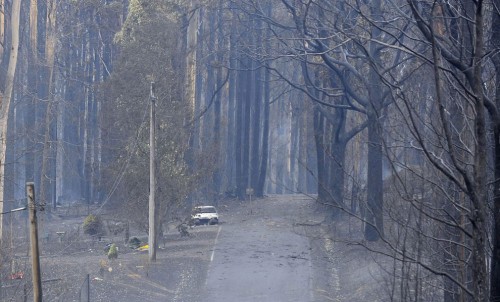
.
1. Purpose of Reform Initiative
.
This reform initiative proposes to standardise and make compulsory throughout the NSW Rural Fire Service the following requirements:
- To record the complete direct and indirect costs attributed to fighting and supporting the fighting of each registered bushfire event received and responded to by the NSW Rural Fire Service (RFS) across New South Wales.
- For each registered fire responded to by the RFS, the combined direct and indirect costs incurred by the RFS and all associated organisations are to be incorporated into the Total Fire Cost of each registered fire.
The purpose of capturing the Total Fire Cost of each registered fire is to establish and maintain a database of the Total Fire Cost for every received and registered fire by the NSW Rural Fire Service across New South Wales.
.
.
2. Recommended Policy
.
The Fire Control Centre of each Rural Fire District in New South Wales must establish and maintain a separate Fire Event Log of each registered fire occurring, either wholly or partially, within its Rural Fire District.
A minimum Australian standard of vital fire information necessary for a Fire Event Log must be established and approved by the NSW Rural Fire Service Commissioner. This standard must be reviewed annually ahead of each peak fire risk season.
A suitable training programme in Fire Event Log Procedures must be established to enable suitable fire personnel to be trained in order to competently maintain a Fire Event Log to the minimum Australian standard.
This policy should be integrated into the RURAL FIRE SERVICE Standard Operating Procedures once a process of consultation with all relevant personnel has been extensively undertaken across the entire breadth of the organisation.
Once approved, a Fire Event Log Policy and Procedures should be gazetted into the Rural Fires Act (NSW), 1997 and considered similarly for each fire authority in each Australian State.
.
.
3. Recommended Procedures
.
1. The Fire Control Centre of each Rural Fire District across New South Wales must establish a new and separate Fire Event Log upon becoming first aware of any fire within its fire district.
2. A Fire Event Log must be maintained continuously throughout the duration of a fire within a Fire District until such time as the responsible Fire Control Officer (or higher RURAL FIRE SERVICE command) declares the fire extinguished within that district.
3. A Fire Event Log must be recorded using the RURAL FIRE SERVICE central computer system, with appropriate daily data back ups generated at the end of each day.
4. The Fire Control Officer for a given Rural Fire District is ultimate responsibile and accountabile for establishing and maintaining an accurate and thorough Fire Event Log for each fire in its district. A Fire Control Officer may only delegate the task of maintaining a Fire Event Log to a qualified fire fighter holding a current endorsement in Fire Event Log Procedures.
5. The Fire Control Officer of each Rural Fire District must endeavour to capture all information about a fire in a separate Bushfire Event Log for each fire (where possible) including, but not limited to:
5.1. The designated name of the subject fire
5.2. Date & time of the ignition
5.3. Location of the ignition
5.4. Cause of the ignition
5.5. GIS digital map updating of the fire spread, likely path and key data
5.6. Details of the initial reporting of the fire outbreak/detection details
5.7. Lapse time to initial response & details of initial response action
5.8. Location of fire(s) & fire behaviour updates at 15 minute intervals
5.9. Local and forecast weather statistics relevant to the fire
5.10. Interstate agencies seconded
5.11. Daily updates on Total Area Burnt
5.12. Daily updates on any lives Lost
5.13. Daily updates on property lost, including number of dwellings
5.14. Daily updates on area of private property & farmland burnt
5.15. Daily updates on areas of mapped high conservation areas burnt
5.16. Daily updates on the number of fire-fighters involved
5.17. Daily updates on the number of aircraft involved
5.18. Daily synopsis on the fire(s) status
5.19. Executive decisions and actions taken, including incident declaration
5.20. Critical issues
5.21. Key operational threats & risks
5.22. Fire resource needs and shortfalls
5.23. Contact details and correspondence with assigned fire investigation
5.24. Total duration of fire activity once extinguished
5.25. Injury Summary Report
5.26. Resource Usage Summary Report by contribution agency
5.27. Register of Support Agency Involvement
6. When a fire takes the form of combined fires or multiple fire fronts within reasonable proximity in a geographic area, the responsible Fire Control Officer may order that a single Fire Event Log be maintained for the combined fires/multiple fire front.
7. Regular communication must be maintained between the Fire Control Centre and field brigades fighting a fire to facilitate logging fire activity to a minimum standard that allows communications at a minimum interval of 15 minutes.
8. Any communications failures or difficulties between firefighting crews (ground and airborne) and Fire Control, or any problems experienced in maintaining a minimum 15 minute communications frequency, must be immediately reported by the Fire Control Officer, or in the case of a major fire incident, to the Incident Controller.
9. A Fire Event Log is to be deemed the official single register of a fire event, a core operational document and a legal document admissible in a court of law.
10. As an internal document, a Fire Event Log is not automatically available for public access. The RURAL FIRE SERVICE Commissioner may at his/her discretion allow public access to such a document via a Freedom of Information Request from a member of the public.
11. The integrity and security of a Fire Event Log is paramount and is the ultimate responsibility of the Fire Control Officer assigned to a given fire. A digital copy of Fire Event Log must be provided by a Rural Fire District branch to RURAL FIRE SERVICE Headquarters within 7 days of the fire being declared extinguished. A secure and accessible database of Fire Event Logs is to be maintained by both the respective Rural Fire District branch and for all fires across NSW by RURAL FIRE SERVICE Headquarters.
 Koala burnt in Victorian Bushfires of February 2009
© Photo by Rebecca Hallas
[Source :http://www.watoday.com.au/national/physical-scars-will-remain-20090211-83u7.html ]
.
. Koala burnt in Victorian Bushfires of February 2009
© Photo by Rebecca Hallas
[Source :http://www.watoday.com.au/national/physical-scars-will-remain-20090211-83u7.html ]
.
.
.
4. Justifications for Reform Initiative
1. While it is acknowledged that the author is not a member of the Rural Fire Service and so privy to existing Rural Fire Service policy and procedures for recording bushfire operations, the lack of operational detail provided the Section 44 Incident Controllers Report for the Nov-06 Grose bushfire and the absence of minutes from the subsequent Inter-Agency review on 19-Dec-06, highlight shortcomings in record keeping of fire operations.
2. Perhaps much of the information reported of bushfire events is obtained from personal recollection of events from individual line personnel a considerable time after the event. For instance, the Section 44 Report into the Grose bushfire (14-Nov-06 to 3-Dec-06) is dated 8-Feb-07, two months later. There are obvious problems relying upon recollecting detailed events, the precise time and order of those events, the changing fire behaviour, the decisions made and actions taken and the changing conditions at the time. The absence of a factual minute by minute event log makes it difficult to be accurate and comprehensive in reporting major bushfire incidents. In the event of a major fire, maintaining a Fire Event Log will provide a record the performance of the four ICS functions – control, operations, planning and logistics.
3. It may well be that bushfire agencies in each Australian state have their own methods and protocols for recording fire events. It may also be that different agencies and indeed different regional branches have their own different ways of recording bushfire event data. There is likely no universal consistent standard across Australia of recording bushfire events as they occur. Some records may be better than others. There is a need to have a consistently high standard of record keeping for bushfire events across Australia.
4. Recent coronial inquests in Australia into bushfire deaths (Canberra Bushfire Jan 2003, Eyre Peninsula Fire Jan 2005), highlight the need for fire authorities need to have accurate records of bushfire events so that they are better able to defend their actions in court.
.
.
5. Benefits of Reform Initiative
.
1. The benefits of establishing and maintaining a Bushfire Event Log is to better enable bushfire management to achieve an accurate and comprehensive record of a fire – the events, decisions and actions and outcomes associated with each fire event. All relevant operational data associated with a fire will be recorded in one convenient document.
2. A Bushfire Event Log will provide a reliable source document for preparing a fire incident report. This will avoid the often difficult task of having to recall events, the order of those events, decisions made along with the fire behaviour at the time, long after a fire sometimes days or weeks later when memories have faded.
3. Recent reports and inquests have highlighted failures in fire-fighting communications, which arguably had a role in contributing to operational problems in controlling the spread, severity and impacts of fires. Compulsorily requiring a Bushfire Event Log will require regular communication between fire-fighters and Fire Control. This requirement will help drive the need to improve the reliability of operational communications during a bushfire event.
4. A Bushfire Event Log will provide a actual live record of the performance of the co-ordination, command and control functions of the ICS, including the operational sequence: Reaction, Reconnaissance, Appreciation, Plan, Issue of Orders and Deployment. This log will be highly useful at a debriefing session following a fire, allowing operational problems to be better identified. This will aid the RURAL FIRE SERVICE to increases its knowledge and understanding of rural fire fighting.
5. A Bushfire Event Log will enable bushfire management to be more transparent in reporting its operations, assisting any possible coronial investigations, for operational evaluation and improvement, analysis and to contribute firefighting practice into bushfire research. By making fire event logging compulsory, regular information must be fed back to central command in order to achieve the minimum reporting standard. This will drive a higher standard in strategic communications.
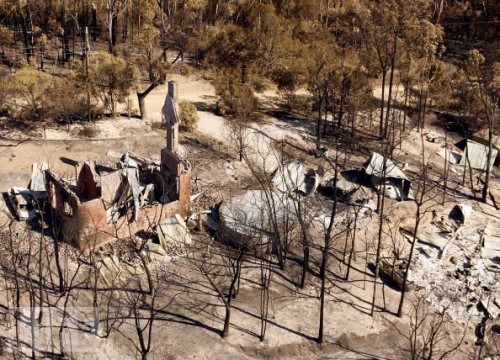 Property incinerated in Kinglake Fire 7th February 2009.
Source: http://www.life.com/image/84754030 Property incinerated in Kinglake Fire 7th February 2009.
Source: http://www.life.com/image/84754030
.
– End of article –
Friday, January 28th, 2011
Australian native forests – are they valuable ecosystems and habitats for wildlife; or bushfire fuel hazards to be burned, before they burn?
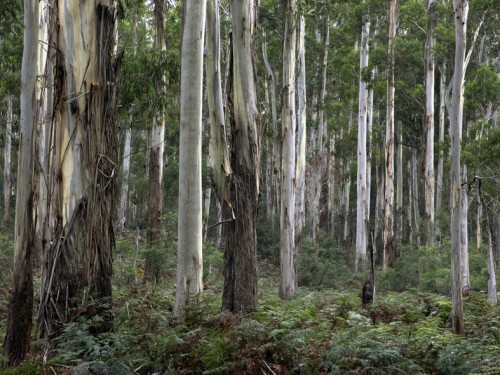 Blue Mountains wet schlerophyl forest
© Photo by Henry Gold, wilderness photographer
. Blue Mountains wet schlerophyl forest
© Photo by Henry Gold, wilderness photographer
.
.
Bushfire Management’s root problems
.
- Bushfire Management which recognises wildlife habitat as an asset worth protecting makes the fire fighting task immensely complex. So moreover the more simplistic and cost saving rationale of ‘protecting life and property’ holds sway, where no thought is given to the conservation values or to the habitat needs of wildlife. The inculcated and unquestioned bushfire management attitude that native forests are the cause of bushfires, rather than being victims of bushfires, belies one of the three key root problems of why bushfire management is failing. Ignitions left to burn in inaccessible terrain time again have proved be devastating not just for nature and wildlife, but consequentially for human life and property. Wildfire does not discriminate.
- Bushfire Management across Australia is so poorly equipped to detect and suppress ignitions when they do occur, that out of frustration, fear has been inculcated to encourage all native forests be dismissed as bushfire hazards and ‘prescribed burned’ as a precaution. Across the New South Wales Rural Fure Service, the term is quite unequivocal – ‘Hazard Reduction‘ . Broadscale hazard reduction, euphemistically labelled ‘strategic burns‘ or deceptively ‘ecological burns‘ and has become the greatest wildlife threatening process across Australia driving wildlife extinctions.’
- Both the localised and regional impacts of bushfire and hazard reduction upon wildlife ecology are not fully understood by the relevant sciences – ecology, biology and zoology. Fire ecology is still an emerging field. The Precautionary Principle is well acknowledged across these earth sciences, yet continues to be dismissed by bushfire management. They know not what they do, but I do not forgive them.
.
Australia’s record of wildlife extinctions are the worst of any country in the past two hundred years.
‘Of the forty mammal species known to have vanished in the world in the last 200 years, almost half have been Australian. Our continent has the worst record of mammal extinctions, with over 65 mammal species having vanished in the last 50 000 years.’ [Chris Johnson, James Cook University, 2006]
.
‘Australia leads the world in mammal extinctions. Over the last two hundred years 22 mammal species have become extinct, and over 100 are now on the threatened and endangered species list, compiled as part of the federal government’s Environment Protection and Biodiversity Conservation Act.’ [Professor Iain Gordon, research scientist in CSIRO’s new Biodiversity Theme, 2009.]
.
Uncontrolled bushfires, broadscale and frequent hazard reduction, and land clearing are the key drivers causing Australia’s remaining wildlife to disappear. Once habitat is destroyed, the landscape becomes favourable to feral predators which kill the remaining unprotected fauna. Thousands of hectares of Australia’s native forests are being burnt every year and are becoming sterile park lands devoid of undergrowth habitat. Wave after wave of habitat threats continue to undermine the layers of resilience of native fauna, until fauna simply have no defences left and populations become reduced to one local extinction after another.
James Woodford in his article ‘The dangers of fighting fire with fire‘ in the Sydney Morning Herald, 8th September 2008, incitefully observed:
‘Fighting fires with fear is a depressing annual event and easy sport on slow news days. Usually the debate fails to ask two crucial questions: does hazard reduction really do anything to save homes, and what’s the cost to native plants and animals caught in burn offs? What we do know is a lot of precious wild places are set on fire, in large part to keep happy those householders whose kitchen windows look out on gum trees.
Hazard reduction burning is flying scientifically blind. Much hazard reduction is performed to create a false sense of security rather than to reduce fire risks, and the effect on wildlife is virtually unknown. An annual bum conducted each year on Montague Island, near Narooma on the NSW far South Coast has become a ritual in which countless animals,including nesting penguins, are roasted.
The sooner we acknowledge this the sooner we can get on with the job of working out whether there is anything we can do to manage fires better. We need to know whether hazard reduction can be done without sending our wildlife down a path of firestick extinctions.’
.
.
‘Koalas may be extinct in seven years’
[Source: Sydney Morning Herald, 20070411]
.
‘Extreme drought, ferocious bushfires and urban development could make koalas extinct within seven years, environmentalists are warning. Alarms about the demise of the iconic and peculiar animal, which sleeps about 20 hours a day and eats only the leaves of the eucalyptus tree, have been raised before.
But Deborah Tabart, chief executive officer of the Australia Koala Foundation, believes the animal’s plight is as bad as she has seen it in her 20 years as a koala advocate.
“In South-East Queensland we had them listed as a vulnerable species which could go to extinction within 10 years. That could now be seven years,” she said. “The koala’s future is obviously bleak.”
South-East Queensland has the strongest koala populations in the vast country, meaning extinction in this area spells disaster for the future of the species, said Tabart.
The biggest threat is the loss of habitat due to road building and development on Australia’s east coast – traditional koala country. The joke, said Tabart, is that koalas enjoy good real estate and are often pushed out of their habitat by farming or development.
“I’ve driven pretty much the whole country and I just see environmental vandalism and destruction everywhere I go,” she said. “It’s a very sorry tale. There are [koala] management problems all over the country.”
Massive bushfires which raged in the country’s south for weeks during the summer, burning a million hectares of land, would also have killed thousands of koalas.’
[Read More]
.
.
‘A Bushfire action plan which protects people, property and nature’
[Source: The wilderness Society, 20090219, http://www.wilderness.org.au/campaigns/forests/bushfire-action-plan]
.
 In the immediate aftermath of the devastating Victorian Bushfires of 2009, The Wilderness Society, in response to bushfire management’s quick blaming of the native forests for the bushfires; drafted a ‘Bushfire Action Plan‘ that sought to recognise the need to protect nature along with people and their property. In the immediate aftermath of the devastating Victorian Bushfires of 2009, The Wilderness Society, in response to bushfire management’s quick blaming of the native forests for the bushfires; drafted a ‘Bushfire Action Plan‘ that sought to recognise the need to protect nature along with people and their property.
.
‘Bushfire remains one of the most complex and difficult aspects of our environment to deal with. Climate change is expected to make things even tougher, with increases in the number of high fire danger days and the number of people and houses at risk increasing with the tree/sea change phenomenon.
With the onset of climate change, mega-bushfires that burn massive areas are expected to occur more often.
A joint CSIRO and Bureau of Meteorology study of the impact of climate change in bushfires found parts of Victoria faced up to 65% more days of extreme fire risk by 2020, and 230% more by mid-century.
Yet clearly we have a lot to learn and the Royal Commission will set a new agenda for land and fire management, prevention and response. Many challenges will remain but some aspects seem clear. We need more money and support for fire fighters if we are to successfully protect life, property and the environment. Two key areas are the early detection of fires including the use of aerial surveillance and remote sensing especially in remote areas, increasing rapid response capacity including more “Elvis” helicopters to fight bushfires as soon as they start.
The outstanding work of firefighters on the front line needs to be backed up with the best available knowledge, planning and resources to ensure operations are as effective as possible in protecting people, property and nature. There is an urgent need to increase investment in these areas and rapidly establish scientific underpinning to fire management, as well as properly resourcing implementation and fire operations.
We also need more information for government and community about how to deliver fire management in a way that also protects the natural environment and our unique wildlife.
Fuel reduction burning has an important place in the fire management toolbox, and we support its place in scientifically underpinned fire management for the protection of life, property and the environment.
The issue of fuel reduction burning often dominates the fire debate, as if it is the only fire management tool. But it’s important to remember that this is only one tool in fire management, and not the silver bullet that will fire proof the landscape.
Environmental groups want to see the science that supports the current fuel reduction program, including a scientific justification for so-called hazard reduction burns in specific areas and the scientific justification for the route and extent of fire break establishment. Environmental groups are particularly concerned about the lack of impact assessment of these programs on biodiversity, particularly given their uncertain benefits to reduce the extent, frequency and severity of fire.
Views on these measures tend towards two extremes. One extreme is that we should fuel reduction burn all forest areas every 20 years and carve out thousands of kilometres of fire breaks, the other is that all our forests are wilderness areas which should just be allowed to burn and not manage our forests for fire at all.
For the Australian bush to be healthy and to protect people, property and nature we need a scientifically based balance between these extremes.
Fire management is not ‘one size fits all’ when it comes to the Australian bush. It needs to be targeted and specific, because we know that different kinds of bush respond differently to fire and therefore need different management. For native plants and animals to survive, fire management needs to promote “good” fire at the right time of year, of the right type and size. And that varies with vegetation type and resident native animals. Grasslands will require more frequent fires compared with forests, while areas such as rainforest will need to be protected from fire altogether.
That’s why we need good ecological science informing fire management, which has come a long way in understanding what’s best for native plants, but we need a better understanding of what fire management is best for protecting wildlife and avoiding extinctions. Its critical that scientists, fire agencies and governments work together to understand how to best manage fire to protect habitat for endangered wildlife, because no one wants fire management to lead to extinctions.
Of course, the protection of life & property needs to come first in fire management – but we can do that while also protecting nature and wildlife. A balanced approach is to prioritise the protection of life and property in areas close to farms and townships, and to prioritise fire management for the environment in remote areas and national parks.
A continuation of the expansion in knowledge, resources and support for fire management and community preparedness will best ensure the protection of life, property and the environment into the future…
.
We have developed a 6-point plan to reduce the bushfire risk and help protect people, property, wildlife and their habitat.
- Improve aerial surveillance to detect bushfires as soon as they start.
- Ramp up hi-tech, quick response capability, including more ‘Elvis’ helicopters to fight bushfires as soon as they ignite.
- More research into fire behaviour and the impact of fire on wildlife and their habitat.
- Around towns and urban areas – prioritise the protection of life and property with fuel reduction and fire break management plans.
- In remote areas and National Parks – prioritise the protection of wildlife and their habitat through scientifically-based fire management plans.
- Make native forests resistant to mega-fires by protecting old-growth forests, rainforests and water catchments from woodchipping and moving logging into existing plantations.
.
.
Critique of Roger Underwood’s Criticism of TWS ‘6-Point Plan‘
.
 On 12th February 2009, Roger Underwood, a former rural firefighter and a forestry industry employee in Western Australia, had his article published in The Australian newspaper criticising the above recommendations of The Wilderness Society (TWS). On 12th February 2009, Roger Underwood, a former rural firefighter and a forestry industry employee in Western Australia, had his article published in The Australian newspaper criticising the above recommendations of The Wilderness Society (TWS).
Regrettably, rather than offering constructive criticism and proposing counter arguments with supportive evidence, Underwood instead dismisses the Wilderness Society’s contribution, but disappointingly with empty rhetoric. Underwood states upfront:
“the trouble with the society’s action plan to reduce the risk of bushfires is that it won’t work.“
.
The Wilderness Society’s six-point action plan aims to counter the current bushfire management strategy that relies upon hazard reduction burning and the ecological damage this is causing – ‘destroying nature’, ‘pushing wildlife closer to extinction’, ‘increasing the fire risk to people and properties by making areas more fire prone’.
Underwood claims that statistics exist showing no massive increase in prescribed burning, but in fact that prescribed burning has declined. Yet Underwood fails to provide nor even reference any such statistics. He fails to recognise that both bushfires and prescribed burning collectively cause adverse impacts on wildlife. If all burning of native vegetation, however caused, is included in the assessment, then would statistics indeed show an increasing trend in the natural area affected by fire in Australia?
.
‘Burn it before it burns’ Theory
.
Underwood questions the wildlife extinction problem without any basis. He then adopts the ”old chestnut‘ theory of blaming the threat to wildlife on ‘killer bushfires‘. ‘Killer bushfires’ (the firestorm threat) has become the default justification by bushfire management for its policy of prescribed burning. This is the ‘Burn it before it burns!‘ defeatist attitude. If one burns the bush, there will be no bush to burn. Underwood’s claim that ‘killer bushfires’ are a “consequence of insufficient prescribed burning” is a self-serving slippery slope fallacy. If nature is an asset of value to be protected, then it is defeatist to damage it to prevent it from damage. The history of so-called ‘controlled burns‘ have an infamous reputation of getting out of control and becoming wildfires. If the attitude of burning as much of the bush as possible to avoid uncontrolled wildfire, then then paradoxically the implied incentive is to let controlled burns burn as much as possible to minimise the risk of unexpected fires in the same area.
.
In respect to each of The Wilderness Society’s (TWS) Six Point Plan, one counters Underwood’s responses as follows:
.
1: Improve aerial surveillance to detect bushfires as soon as they start
.
Underwood supports aerial detection as “a first-rate resource and a comprehensive system” but says that it can fail completely under hot, unstable atmospheric conditions and when there are very high winds. However, fire towers and aircraft are not the means of bushfire surveillance today. Low orbiting geostationary satellites with infrared and high resolution cameras can now spot individual cars in real time and through cloud and smoke. Satellites are not affected by atmospheric conditions such as high winds or hot temperatures. Modis-Fire is one company that specialises in such satellite technologies.
In addition, the CSIRO, with the Department of Defence and Geoscience Australia, has developed an internet-based satellite mapping system called ‘Sentinel Hotspots‘. Sentinel Hotspots gives emergency service managers access to the latest fire location information using satellite data. Fire fighting organisations across Australia have used this new strategic management tool, since it was launched in 2002, to identify and zoom in on fire hotspots. [Read More]
In 2003, an article in the International Journal of Wildland Fire entitled ‘Feasibility of forest-fire smoke detection using lidar‘ extolled the virtues of forest fire detection by smoke sensing with single-wavelength lidar.
Such technologies are available if the political will was met with appropriate investment. Such technologies could be available to a military-controlled national body, but unlikely to be available to volunteer members of the public. It all depends on the standard of performance Australians expect from bushfire management.
.
2: Ramp up hi-tech, quick response capability, including more ‘Elvis’ helicopters to fight bushfires as soon as they ignite.
.
Underwood dismisses aerial fire-bombing as a “dream” that “has never succeeded in Australia, and not even in the US” and “next to useless“.
Well, it seems Underwood is contradicted by the recent decisions of Australia State Governments across Australia’s eastern seaboard to charter not just one Erikson Aircrane but three. Not only was Elvis contracted from the United States in Summer 2010 to Victoria, “Elvis” was based in Essendon, ‘Marty‘ was based in Gippsland and ‘Elsie‘ was based in Ballarat. Clearly, the Victorian State Government considers the cost of these three aircraft justifiably cost-effective in offering quick response capability to fight bushfires.
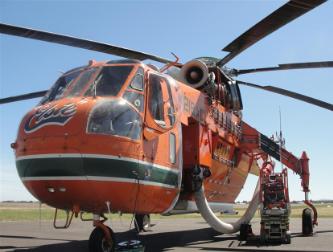 Dedicated Fire Fighting Erikson Aircrane ‘Elsie‘ based in Ballarat, Victoria during the 2010 Summer
© Photo ABC Ballarat http://www.abc.net.au/local/audio/2010/12/22/3099609.htm
.
In South Australia, the Country Fire Service (CFS) believes in the philosophy of hitting a fire ‘hard and fast’.
.
‘CFS volunteers and aerial firefighting aircraft are responded within minutes of a bushfire being reported and as many resources as possible are deployed to keep the fire small and reduce the chance of it getting out of control. It is not widely known that South Australia has a world class initial attack strategy of aerial firefighting. The value of a rapid aerial firefighting approach has been supported by Bushfire Cooperative Research Centre research. In their 2009 report titled ‘The cost-effectiveness of aerial fire fighting in Australia, the Research Centre wrote the following in their summary
.
The results of the analysis show that the use of ground resources with initial aerial support is the most economically efficient approach to fire suppression. Aircraft are economically efficient where they are able to reach and knock down a fire well before the ground crew arrives. This buys time for the ground forces to arrive and complete the containment. Rapid deployment of aerial suppression resources is important. This advantage is much greater in remote or otherwise inaccessible terrain. Where other suppression resources are unable to reach the fire event within a reasonable time period, sole use of aircraft is economically justified.’
[http://www.bushfirecrc.com.au/research/downloads/The-Cost-Effectiveness-of-Aerial-Fire-Fighting-in-Australia.pdf].
. Dedicated Fire Fighting Erikson Aircrane ‘Elsie‘ based in Ballarat, Victoria during the 2010 Summer
© Photo ABC Ballarat http://www.abc.net.au/local/audio/2010/12/22/3099609.htm
.
In South Australia, the Country Fire Service (CFS) believes in the philosophy of hitting a fire ‘hard and fast’.
.
‘CFS volunteers and aerial firefighting aircraft are responded within minutes of a bushfire being reported and as many resources as possible are deployed to keep the fire small and reduce the chance of it getting out of control. It is not widely known that South Australia has a world class initial attack strategy of aerial firefighting. The value of a rapid aerial firefighting approach has been supported by Bushfire Cooperative Research Centre research. In their 2009 report titled ‘The cost-effectiveness of aerial fire fighting in Australia, the Research Centre wrote the following in their summary
.
The results of the analysis show that the use of ground resources with initial aerial support is the most economically efficient approach to fire suppression. Aircraft are economically efficient where they are able to reach and knock down a fire well before the ground crew arrives. This buys time for the ground forces to arrive and complete the containment. Rapid deployment of aerial suppression resources is important. This advantage is much greater in remote or otherwise inaccessible terrain. Where other suppression resources are unable to reach the fire event within a reasonable time period, sole use of aircraft is economically justified.’
[http://www.bushfirecrc.com.au/research/downloads/The-Cost-Effectiveness-of-Aerial-Fire-Fighting-in-Australia.pdf].
.
Underwood claims that: “Elvis-type aircranes cost a fortune, burn massive amounts of fossil fuel, use gigalitres of precious water and are ineffective in stopping the run of a crown fire that is throwing spot fires. Water bombers do good work protecting houses from small grass fires. But against a big, hot forest fire and during night-time they are next to useless.”
Underwood conveys a sense of dogged reliance in traditional fire truck centric thinking as if to preserve an old firie culture of ‘we know best‘ and ‘nothing is going to change our thinking‘ mindset. May be it is out of petty envy wherein many volunteer firies can command trucks but wouldn’t have a clue flying helicopters and so would feel sidelined.
Well, since the 2009 Victorian Bushfires, more than A$50 million worth of new initiatives have been introduced or are under development.
“Further changes are likely to be introduced as the Royal Commission, which was established to investigate the Black Saturday disaster, is ongoing. Aerial firefighting is set to be addressed by the commission. Among new initiatives in Victoria is a A$10 million trial of a very large air tanker (VLAT) – the first-ever such experiment in the country. On 14 December, a McDonnell Douglas DC-10-30 Super Tanker, leased from US company 10 Tanker Air Carrier, arrived in Melbourne. Australian regulator, the Civil Aviation Safety Authority, and underwent final compliance assessment to allow it to enter service in January.”
.
[Source : http://www.flightglobal.com/articles/2010/02/09/338056/australia-puts-firefighting-tankers-to-the-test.html]
Underwood may well dismiss aerial suppression technology as ‘razzle-dazzle‘, but he is right to state that such investment requires governments to put more resources into research and into monitoring bushfire outcomes, including the environmental impacts of large, high-intensity bushfires and continuous feedback to management systems from real-world experience out in the forest.’
.
3: More research into fire behaviour and the impact of fire on wildlife and their habitat
.
While Underwood claims that he supports more research into fire behaviour and fire impacts, he is dismissive of the conclusions of much of the research already done, but offers no explanation. This seems an internal contradiction. What are the conclusions of the research?
Underwood claims the conclusions do not support the Wilderness Society’s agenda. How so? What is TWS agenda?
Underwood conveys an unsubstantiated bias against the Wilderness Society, only offering an ad hominem fallacious argument – attacking the messenger, not the argument.
.
The science on fire ecology is still emerging. The Wilderness Society validly states above that ‘bushfire remains one of the most complex and difficult aspects of our environment to deal with‘, that ‘there is an urgent need to increase investment in these areas and rapidly establish scientific underpinning to fire management, as well as properly resourcing implementation and fire operations‘ and ‘the lack of impact assessment of these programs on biodiversity, particularly given their uncertain benefits to reduce the extent, frequency and severity of fire‘.
.
4: Around towns and urban areas – prioritise the protection of life and property with fuel reduction and fire break management plans.
.
Underwood here perceives an inconsistency in TWS Action Plan – suggesting its support for fuel reduction around urban areas contradicts its claim that fuel reduction makes the burned areas “more fire prone”. However, this action item is about prioritising fuel reduction on a localised basis around the immediate areas where life and property are located.
Whereas broadscale hazard reduction that is carried out many miles from human settlements has become a new strategy of bushfire management. The excuse used is euphemistically termed a ‘strategic burn‘ or even an ‘ecological burn‘ in the name of encouraging biodiversity. Except that the practice seems to be a leftover habit from the Vietnam War in which helicopters are used to drop incendiaries indiscriminately into remote areas without any care for the consequences.
 A so-called ‘ecological burn‘ of Mt Cloudmaker
This was conducted by helicopter incendiary by NSW National Parks and Wildlife Service (DECCW)
in the remote Krungle Bungle Range of the Blue Mountains World Heritage Area
(Photo by editor from Hargraves Lookout, Shipley Plateau, 20080405 , free in public domain) A so-called ‘ecological burn‘ of Mt Cloudmaker
This was conducted by helicopter incendiary by NSW National Parks and Wildlife Service (DECCW)
in the remote Krungle Bungle Range of the Blue Mountains World Heritage Area
(Photo by editor from Hargraves Lookout, Shipley Plateau, 20080405 , free in public domain)
.
A recent example is the ‘strategic burn’ authorised and executed by the NSW Department of Environment, Climate Change and Water (DECCW) in the Blue Mountains World Heritage Area on 12th May 2010. Some 2500 hectares of remote wilderness was deliberately set alight around Massif Ridge, some 12 kilometres south of the town of Woodford in wild inaccessible forested area of the World Heritage Area. The excuse was to reduce the available ‘fuel’ (native vegetation) for potential future wildfires. [>Read More: ‘National Parks burning biodiversity‘ ]
.
5: In remote areas and National Parks – prioritise the protection of wildlife and their habitat through scientifically-based fire management plans.
.
Underwood contends another stock standard industry claim that where native forests have been protected, they have naturally accumulated fuel loads in which sooner or later an uncontrollable landscape-level fire occurs. So his anthropocentric theory runs that is humanity’s responsibility not to let nature be nature, but to control nature and so to burn the bush before it burns. This theory is premised on the defeatist approach that in the event of a bushfire, bushfire management is not in a position to detect and suppress it.
And so Underwood, poses the standard industry response of “more frequent planned burning under mild conditions“. He assumes that leaving the overstorey and the soil intact will ensures a diversity of habitat for wildlife. Yet Underwood is not a zoologist and has no understanding of the vital role that dense ground vegetation provides to Australia’s native ground dwelling mammals (e.g.the Long-footed Potoroo, Spotted-tailed quoll, Eastern Pygmy Possum, the Petrogale penicillata, Broad-toothed Rat, Bolam’s Mouse, the Smoky Mouse, the Eastern Chestnut Mouse, the Long-nosed Bandicoot), as well as nexting birds, flightless birds, amphibians and reptiles.
 Eastern Quoll – Dasyurus viverrinus – EXTINCT on mainland Australia
© Photo by Andrea Little http://www.mtrothwell.com.au/gallery.html Eastern Quoll – Dasyurus viverrinus – EXTINCT on mainland Australia
© Photo by Andrea Little http://www.mtrothwell.com.au/gallery.html
.
Underwood’s view reflects the simplistic misguided view of biodiversity of most of Australia’s bushfire management – that the presence of trees and regrowth of fire-tolerant plants equates to biodiversity.
Can Underwood name one species of Australian fauna that is fire tolerant?
Underwood misinterprets the text of TWS which advocates an holistic fire management system, not as a silver bullet or ‘one-size-fits- all’ convenient panacea that pretends to fire proof the landscape. The only guarantee of ‘one-size-fits- all’ hazard recution is a sterile forest devoid of biodiversity and causing local species extinctions. TWS argues for a scientifically-based and balance approach recognising that some forest ecosystems like rainforests are most definitively fire-intolerant.
.
6: Make native forests resistant to mega-fires by protecting old-growth forests, rainforests and water catchments from woodchipping and moving logging into existing plantations
Underwood challenges this last item stating there is no evidence that old growth forest is less likely to burn than the regrowth forests. This is false. Australian native forests that regrow after fire are those that are fire-resistant. Typically, these genus (Eucalypt and Acacia) regrow quickly and become dense mono-cultures. If a fire passes through again, the fire is often more intense and devastating. Old growth forests, rainforests and riparian vegetation around water catchments tend to be moist and so less prone to bushfires.
But this sixth item is not about the relative propensity of old growth forests to burn more readily than regrowth forests, so Underwood’s argument is a distracting red herring. TWS’ aim here is more about placing a higher value on old growth and rainforests due to their greater biodiversity and due to their increasing scarcity. Clearly, TWS is ideologically opposed to woodchipping and logging of old growth forests and rainforests. Logging operations typically involve follow up deliberate burning and such fires have frequently got out of control. Underwood’s needling criticism of TWS for having a lack of knowledge of fire physics or bushfire experience is a typical defensive criticism leveled at anyone who dares to challenge bushfire management. Conversely, if Underwood has the prerequisite knowledge of fire physics or bushfire experience, he is not very forthcoming except to defend the status quo of bushfire management.
The recent bushfire results are demonstrating that bushfire management is increasingly unable to cope with bushfire catastrophes nor meet the expectations of the public to protect life, property and nature.
.
.
Further Reading:
.
[1] ‘Studies of the ground-dwelling mammals of eucalypt forests in south-eastern New South Wales: the species, their abundance and distribution‘ by PC Catling and RJ Burt, CSIRO, 1994, http://www.publish.csiro.au/paper/WR9940219.htm
.
[2] ‘Australia’s Mammal Extinctions – A 50,000-Year History‘, by Chris Johnson, 2006, James Cook University, North Queensland. http://www.cambridge.org/aus/catalogue/catalogue.asp?isbn=9780521686600
.
[3] ‘Solving Australia’s mammal extinction crisis‘, (2009) by Professor Iain Gordon, research scientist in CSIRO’s new Biodiversity Theme, ABC Science programme. He chaired a symposium on Australia’s mammal extinction crisis at the 10th International Congress of Ecology in Brisbane August 2009. http://www.abc.net.au/science/articles/2009/09/02/2674674.htm
.
[4] ‘Koalas may be extinct in seven years‘ , Sydney Morning Herald, 20070411, http://www.smh.com.au/news/environment/koalas-may-be-extinct-in-seven-years/2007/04/11/1175971155875.html
.
[5] ‘A Bushfire action plan which protects people, property and nature‘, The Wilderness Society, 20090219, http://www.wilderness.org.au/campaigns/forests/bushfire-action-plan
.
[6] ‘Manage bush better so climate won’t matter‘, by Roger Underwood (ex-firefighter), The Australian newspaper, 20090212, http://www.theaustralian.com.au/news/manage-bush-better-so-climate-wont-matter/story-e6frg73o-1111118824093
.
[7] ‘Locating bushfires as they happen‘, CSIRO – Sentinel Hotspots, http://www.csiro.au/solutions/Sentinel.html
.
[8] ‘Modis-Fire’ satellite bushfire detection, http://modis-fire.umd.edu/Active_Fire_Products.html
.
[9] ‘Elsie’s first day on the job, Ballarat’s fire fighting helicopter‘, by Prue Bentley (ABC TV Ballarat), 20101222, http://www.abc.net.au/local/audio/2010/12/22/3099609.htm
.
[10] ‘South Australia – Country Fire Service – Factors that influence aircraft selection‘ – http://www.cfs.sa.gov.au/site/about_us/aerial_firefighting/aircraft_selection.jsp
.
[11] ‘Australia puts firefighting tankers to the test‘, Fight Global 20090209, http://www.flightglobal.com/articles/2010/02/09/338056/australia-puts-firefighting-tankers-to-the-test.html
.
[12] ‘Bushfire-CRC – Aviation content’, http://www.bushfirecrc.com/category/bushfiretopic/aviation.
.
[13] ‘Towards New Information Tools for Understanding Bushfire Risk at the Urban Interface‘, 2004, R. Blanchi, J. Leonard, D. Maughan, Bushfire-CRC, CSIRO Manufacturing & Infrastructure Technology, Bushfire Research. [Read full report]
[end of article]
.
Tags: Australian native forests, Blue Mountains wildlife, broadscale burning, bushfire action plan, Bushfire-CRC, Chris Johnson, CSIRO, dangers of fighting fire with fire, eastern quoll, ecological burn, Erikson Aircrane, fire-intolerant, fuel reduction, fuel reduction program, ground dwelling mammals, hazard reduction, Henry Gold, koala extinction, mammal extinctions, Modis Fire, Montague Island hazard reduction, precautionary principle, precribed burning, Professor Iain Gordon, Roger Underwood, Rural Fire Service, Sentinel Hotspots, sterlisation of forests, strategic asset management, The Wilderness Society, threatening process, Victorian Bushfires 2009, wildfire, wildlife extinctions, wildlife habitat
Posted in Blue Mountains (AU), Threats from Bushfire | No Comments »
Add this post to Del.icio.us - Digg
Tuesday, December 21st, 2010
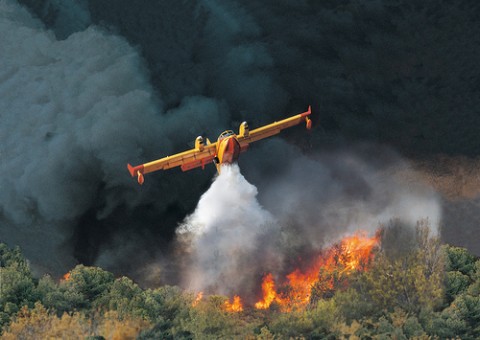 Bombardier 415
“This amphibious aircraft is the backbone of firefighting missions around the globe. Launched in 1994, this high-wing, all-metal amphibian remains the only aircraft specifically designed for aerial firefighting. Its proven technology and fire-extinguishing power make it the most effective machine for the job.”
Photo: ©1997 Bombardier Aerospace. http://www.aerospace-technology.com/projects/bombardier_415/images/415_1.jpg Bombardier 415
“This amphibious aircraft is the backbone of firefighting missions around the globe. Launched in 1994, this high-wing, all-metal amphibian remains the only aircraft specifically designed for aerial firefighting. Its proven technology and fire-extinguishing power make it the most effective machine for the job.”
Photo: ©1997 Bombardier Aerospace. http://www.aerospace-technology.com/projects/bombardier_415/images/415_1.jpg
.
A proven effective strategy against bushfires is early detection and response to ignitions.
Suppressing and ignition before it spreads seems logical enough, although perhaps with existing Rural Fire Service (RFS) is easier said than done. But is funding, and are RFS ‘fuel management’ strategies focusing on this albeit logical fire-fighting solution?
The Blackheath Glen wildfire (reportedly lit by bush arsonists, unconvicted) that started on 13th December 2002 was confirmed as having spread over 13 kilometres in less than six hours. By simple calculation the fire was travelling at less than 3kph. Why was it not detected early and suppressed?
Bushfire ignitions should be responded to before growing into uncontrollable wildlife fronts. Relying upon phone calls from the public to ‘000’ shouldn’t be a main detection mechanism, especially during times of known extreme bushfire (arson) risk.
Constant monitoring of bushfire prone bushland during the high risk season is crucial if we are serious about early detection. These days we have sophisticated long-range digital video cameras, radar and real-time satellite infrared cameras that can pick up individual trees! Perhaps the RFS should also have dedicated airborne fire surveillance crews. As for operational response, are fire crews sited in the most strategic response locations 24/7 on standby?
Is bushfire modelling and are the fire history databases utilised to allocate crews strategically to vulnerable and probable ignition locations? Stand-by helicopter air cranes equipped with water bombing capability provide faster response and superior access than truck-based crews.
Such solutions exist, yet require sophisticated resources, management and cost millions.
We choose to build closer to the bush, but are we serious about protecting lives and million of dollars worth of property from bushfire? Can we afford to rely on a grant and raffle-funded volunteer force or is it time to evolve the RFS into a specialist division of the NSW Fire Brigade and seriously resource it?
[This letter by this editor was first published in the Blue Mountains Gazette, 7th December 2005 on page 10]
.
.
Reader feedback to this letter at the time:
.
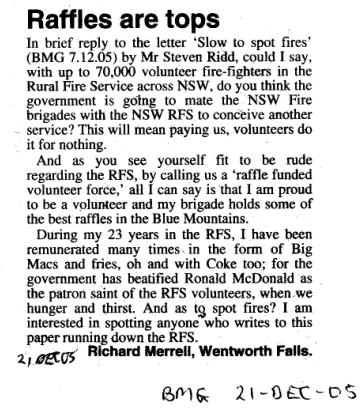
Monday, December 20th, 2010
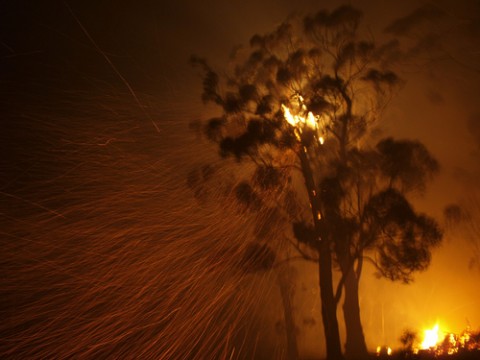 Ember attack during a bushfire.
Photo © Country Fire Service, South Australia. http://www.cfs.sa.gov.au/ Ember attack during a bushfire.
Photo © Country Fire Service, South Australia. http://www.cfs.sa.gov.au/
.
[The following letter was first published in the Blue Mountains Gazette, 16-Nov-2005, contributed by the editor as Director, Colong Foundation for Wilderness. It sparked a debate in this local paper over successive months and preceded the 2006 Grose Fire in the Blue Mountains, possibly the worst fire storm in the history of the Blue Mountains.]
.
‘Premises at Risk’
Part and parcel of choosing to live in the Blue Mountains is that, by being on ridge lines surrounded by Eucalypt forests, many properties are inherently exposed to bushfire threat. Whether bushfires be caused by lightning (rarely), accidentally by people, RFS-prescribed, or by arson (usually); bushfire risk management is a community responsibility – not just the lot of RFS volunteers. The arson threat aside, “residents, landowners and land managers of the Blue Mountains need to accept that they are in a bushfire prone area and their properties may be subject to ember attack when threatened by bushfire.” (Blue Mountains Conservation Society Bushfire Policy).
To dispel a rural myth, not all native habitats recover from bushfire. Certain species and old growth flourish only in ecosystems that are never burnt. Post-bushfire regrowth often spawns dominant species like Eucalypt and Acacia, whereas original biodiversity may take centuries to recover. Bushfire is often a precursor to infestations of grass and weeds, and if followed by intense rain, also a catalyst for eroding irreplaceable native soils.
The antique premise ‘hazard reduction’ has become spin for pre-emptive burning that is prone to escaping out of control and so itself a hazard. Slashing and bulldozing under the premise of ‘Asset Protection Zone’ is also proving to be ineffective against ember attack and wildfire. But like arson, the hazard reduction and APZ theories contribute to the net loss of important habitat.
Proven effective and sustainable is early detection and response to ignitions. Most artificial fires start on developed land, so this in where the control measures should be focused – maintenance of gardens and guttering, retrofitting houses with materials and defences to resist fire, planting fire-retardant hedging around houses and implementing counter-measures recommended by Australian Standard AS3959.
The future of sustainable bushfire risk management starts by preventing houses being built where they cannot be safely protected from bushfires. Effective ‘hazard reduction’ is investigating and catching the arsonists.
.
.
Reply by District Manager, Rural Fire Service (RFS) Blue Mountains, Mal Cronstedt, 20060104 [Cronstedt ten month later was in charge of the response to the Grose Fire]:
.
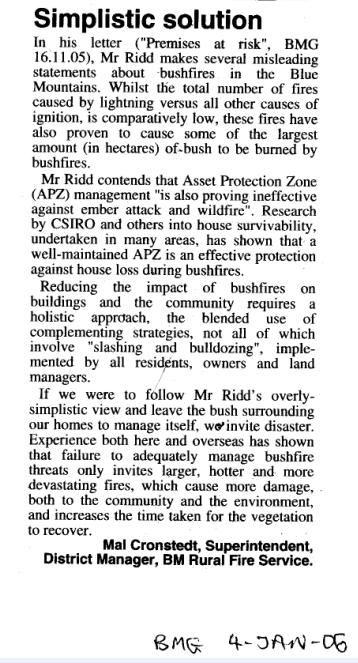
.
.
Reply by local Architect, Nigel Bell, 20060118:
.
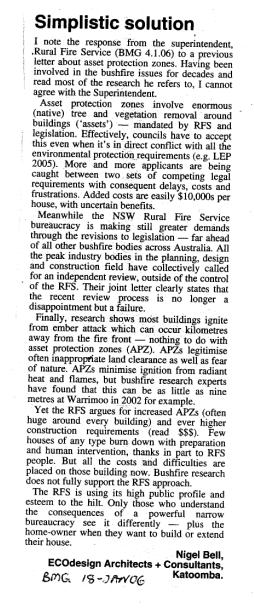
.
.
Counter reply by editor 20060222, page 10:
.
World Hazard Area?
I welcome RFS BM Superintendent’s response (BMG 4-1-06) to my letter (‘Premises at Risk’ BMG 16-11-05) and him challenging two of many researched points I raised.
In reply, my statements were not “misleading”. RFS’s own research confirms that most bushfires are caused by arson. Of 466 investigated fires in NSW (2001-2004), 296 (64%) were determined to be the result of deliberate ignition and the most prominent cause of significant bushfires. (Australian Institute of Criminology, Bushfire Arson Bulletin, 16-8-05).
In reply, an RFS ‘Asset Protection Zone’ will not stop a raging wildfire “with flames of up to 30m” nor stop embers carried by hot “60kph” winds well ahead of a wildfire front (Woy Woy). Burning/bulldozing bush, before arsonists get to it, is flawed logic. How many hectares of habitat would need to be destroyed to insulate bushfire-prone property from wildfire? Wildfires need not be inevitable. Wildfire fronts are often caused by an excitement-motivated arsonist’s multiple ignitions linking up.
I unreservedly commend the dedication of RFS volunteers each Summer. But habitat-destroying strategies applied by RFS bushfire committees each Autumn-Spring hark to 1940s solutions and are as ineffective as they are environmentally destructive. ‘Hazard’ reduction assumes a direct relationship between wildfire risk and the total area burned. But ‘hazard’ reduction does not significantly reduce wildfire risk. In 2003, the Auditor General of Victoria identified in his audit on fire prevention and preparedness, that “the relationship between hazard reduction burning and the overall wildfire risk is currently limited”.
Mal, no-one said solutions were simple. But to be effective, bushfire risk management must focus on the root causes – by (1) seriously resourcing investigation into bush arson, and (2) ambulance-speed detection and suppression of spot fires – else we do “invite disaster”! Our World Heritage need not be a wedge victim between ‘hazard’ reduction and serial arsonists.
.
.
.
Reply by RFS Blue Mountains Bushfire Management Committee member, Hugh Paterson, 20060405, page 10:
.
 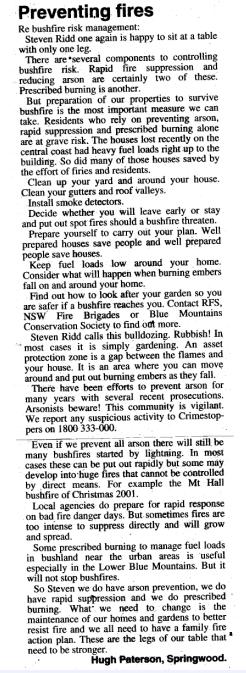
.
.
Counter reply by editor 20060426:
.
‘Land Clearing Immunity’
.
I welcome Hugh Patterson’s public input into the environmentally destructive practice of ‘hazard’ reduction (BMG 5-4-06). Conspicuously, none of the repeated research refuting the fallacy that ‘prescribed’ burning and bulldozing native habitat prevents wildfires, is disputed.
Hugh claims the Mt Hall bushfire in 2001 could not be controlled. But the coronial enquiry noted: “prescribed burns had been done… only two years and four months earlier” and “the ability of the fire to leap or bound many hundreds of metres at a time.” Reconfirmation that ‘hazard’ reduction does not prevent wildfires.
Why was the initial spot fire at Mt Hall not detected sooner and standby airborne water-bombing deployed?
Resourcing is clearly available when bushfire co-ordination committees can command millions in federal funding each year to perpetuate ‘hazard’ reduction – an unquestioned tradition dating back over 50 years. Last year these committees squandered $1.3 million ‘hazard’ reducing 3785 km2 of National Parks habitat, 565 km2 of Crown Land, and a further 391 km2 of local council-owned lands across NSW.
‘Hazard’ reduction is blatant land clearing. Worse, ‘mechanical’ hazard reduction (ie: bulldozing) permanently destroys habitat. Anyone else – farmers, developers, would attract severe penalties as environmental vandals. But these bushfire committees operate immune from EPA prosecution, write their own rules and code with eco-friendly jargon then call in the bulldozer anyway.
The discretionary millions deserve to be invested in effective detection and airborne suppression of spot fires, not squandered on finding something for volunteers to do over winter, which wildfires leap over anyway. According to the mayor of Junee last summer, “if it hadn’t been for the water-bombing aircraft half of Junee would have gone”.
Anyone arguing to divert scarce grant funding away from effective airborne fire-fighting and to justify futile habitat destruction doesn’t have a moral leg to stand on.
.
.
Reply by RFS Group Captain, Donald Luscombe 20060503:
.
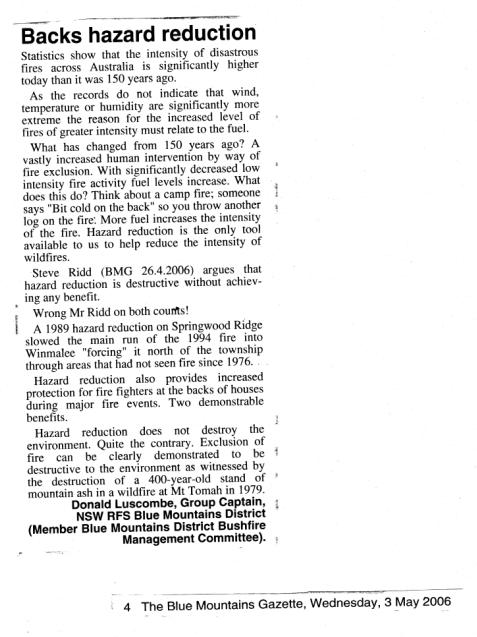 . .
.
Reply by local resident, Elizabeth Saxton, 20060517:
 . .
.
Reply by Donald Luscombe (RFS) 20060517:
.
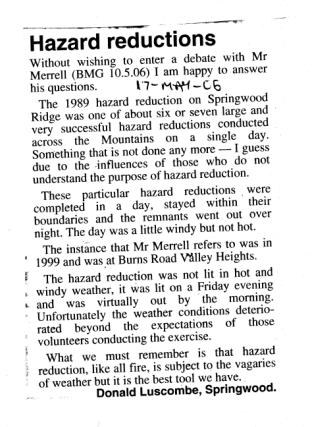
.
.
Counter reply by editor 20060524:
.
‘Heed the Research’
In the 1940s, ‘hazard’ reduction was a knee-jerk response in the wake of the Black Friday firestorms. The bushfire-prone nature of our community should compel us all to frequently look towards better solutions for bushfire prevention and suppression. We need to heed the latest investigative bushfire research telling us what’s effective and what’s not effective, then exercise best practice.
The research keeps reconfirming that hazard reduction is not effective. At the Adelaide Bushfire Conference 2004, research concluded that 90% of houses ignited in Australian bushfires are due to ember attack. ‘Hazard’ reduction does not prevent ember attack, so how does its stop the remaining 10%?
By walking around with petrol torches ‘hazard` reducing, volunteers are reducing habitat and reducing themselves to arson. Our actions need to respect both our built and natural assets. Most of us value our special Blue Mountains natural environment, otherwise why choose to live here and not in Portland or Pyrmont, where trees are scarce and concrete has eliminated bushfire risk?
Research into the Warrimoo, Valley Heights and Yellow Rock bushfires of 2001-2 concluded that the main cause of houses destroyed by bushfire was from burning debris (ember attack) allowed to gain entry into houses through inadvertent openings. Houses-by-house, those that survived were due to vigilant intervention by those present putting out small fires after the fire front had actually passed. CSIRO Research (1999) into causes of building loss from bushfires in Hobart (1967), Blue Mountains (1968), Otway and Macedon Ranges (1983), and Sydney 1994) confirmed the same and advocated focus on landscaping and building design strategies. Out of the 2001/2002 NSW bushfires, Sydney Councils recommended Sydney Water increase mains water capacity during bushfire crises.
Research literature is not widely promulgated, which means that the wider community must re-learn lessons in the wake of subsequent bushfires.
.
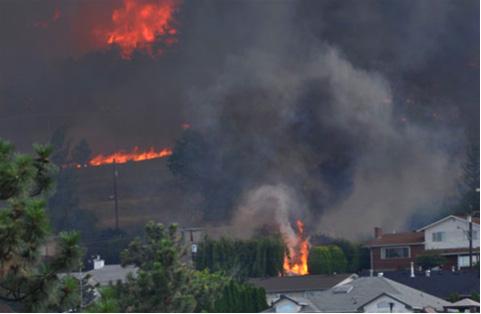 Burning hedge, lit by ember attack.
Photo © City of Kamloops, British Columbia, Canada.
http://www.city.kamloops.bc.ca/firerescue/images/burningHedge.jpg Burning hedge, lit by ember attack.
Photo © City of Kamloops, British Columbia, Canada.
http://www.city.kamloops.bc.ca/firerescue/images/burningHedge.jpg
.
Reply by Donald Luscombe (RFS) 20060531:
.
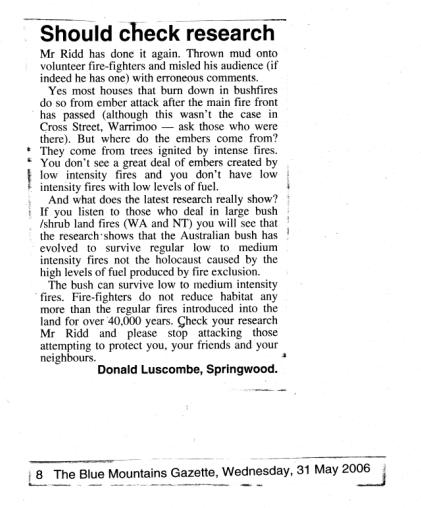
.
.
Counter reply by editor 20060607:
.
‘Prescribed Extinction’
Perhaps like all residents, I wholeheartedly commend the dedication of RFS fire fighters fighting bushfires. I reaffirm this in rebuff to the misrepresenting tirade from Blue Mountains Bushfire Committee boss, Mr Luscombe (BMG 31-5-06).
The big local environmental issue continues to be the hundreds of Blue Mountains hectares cleared every autumn under the pretext of defending houses.
Mr Luscombe agrees the main cause of bushfire damage to houses is ember attack AFTER a fire front has passed. But he contradicts himself by justifying the need for hazard reduction in autumn BEFORE the risk season even starts. Clearly, hazard reduction is about thinning bush to minimise the intensity of a possible fire front, yet we agree the fire front itself isn’t the cause of house damage. Mr Luscombe is putting out the wrong fires. A sledgehammer approach to bushfire risk management won’t prevent wildfires or embers, but it will stuff forest ecology. I say it again – ‘hazard’ reduction is land clearing – an environmentally unsustainable practice all participants should critically question.
Extensive field research by Catling (1991) of the CSIRO Division of Wildlife Ecology has shown that “vertebrate fauna of south-eastern Australia is most abundant in forests with a dense understorey.” “If shrubs, litter and ground cover are removed, reduction in complexity of forest structure leads to a reduction in abundance and species diversity of small mammals” (Lunney 1987, Royal Zoological Society of NSW). Frequent, low-intensity burns in autumn reduce and eventually eliminate dense understorey – because rain and warm weather needed for regrowth are denied. As understorey is lost, threatened ground-dwelling native mammals (Tiger Quolls, Eastern Pygmy Possums, Rufous Bettongs) lose habitat protection, while many exotic species (foxes, feral cats, black rats) are advantaged.
On 28th April, ‘hazard’ reduction burning was prescribed for 347ha of the World Heritage Jamison Valley.
.
.
Counter reply by editor 20060719:
.
‘Slowly Cooking Habitat’
In the landmark book advocating the now famous Bradley method of bush regeneration by the Bradley sisters, ‘Bringing Back the Bush’ (1988), Joan Bradley challenged the 1940’s hazard reduction practices which still perpetuate unchecked today:
“One of the many myths about Australian vegetation is that occasional fire is essential for its renewal and that only natives are affected in this way by fire. But natives are not the only plants to flourish on an ashbed. I do not know of a single bush invading weed which does not respond in exactly the same way. Seeds germinate in abundance, and (weeds), like dahlias, lasiandra, cotoneaster, lantana and privet shoot from their base like gum trees.”
“Hazard-reduction fire is completely different from a real bushfire. Burning is done at the time of the year when the bush is dormant, and on the ground the leaf mulch is heavy and moist. For this reason it must be deliberately lit, frequently many times, whereupon it smokes, smoulders and steams. This type of burn consumes only the understorey. The ground smells like a garden rubbish heap, not a bit like bush after a bushfire, because the mulch is left to steam at high temperatures, and then putrefy.”
“It should be remembered that in the cooler seasons, plants and trees are storing food in their roots, ready for the surge of growth in spring, so this is not just an unnatural and unwelcome interruption to the vital feeding process. It is a major setback, as it was intended.”
“A prescribed burn has a disastrous effect on native plants and an absolutely explosive effect on weeds. With the understorey gone, the soil…is exposed to light which weeds thoroughly enjoy. The slow and uneven growth of the native plants (during the cooler seasons) does little to keep (weeds) in check.”
.
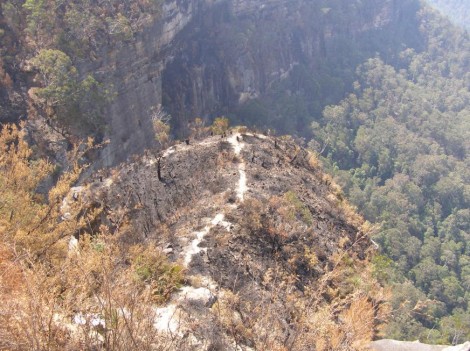 Result of defacto hazard reduction below Govetts Leap, Grose Valley, Blue Mountains
Photo by editor 20061209 free in public domain. Result of defacto hazard reduction below Govetts Leap, Grose Valley, Blue Mountains
Photo by editor 20061209 free in public domain.
-end of article –
|
|





































































